![800px-Aberlemno_III_symbols[1]](https://esotericbasics.co.uk/wp-content/uploads/800px-Aberlemno_III_symbols1-224x300.jpg)
''Mostly come in pairs...one or two pairs''. Quote in relation to 'Pict' symbols. Coincidence? Others elsewhere.
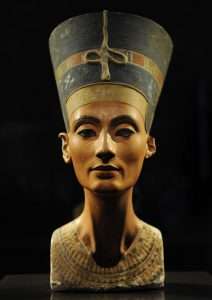
'Stamp of the feminine'? Real or symbolic?
Yet the folk-theme has remained constant to the elements of the act, which derives from the 'worship' of a Mother-Lover-Goddess in whose control all life, and all death were held... These two brothers have fought there way through human consciousness during the entire history of mans existence. The list of their names [apart from Jack and John as the ballads always calls them] is long indeed: Horus and Set {or should that be Set/Osiris. Enlarged further on}. Cain and Able; Beli and Bran; Balin and Balan, the pattern is the same. Light and dark; good and evil; winter and summer; positive and negative; Michael and Lucifer; Christ and Satan; life and death - all forms of metaphysical pairing of opposites...The resolving element in this eternal struggle is the Goddess ['anima' link. This readers input] who restores...Most variants involve a battle of wrestling, which seems to turn into accidental death by stabbing [spear/lance symbolism link]. Curiously, the practice of wrestling has a religious significance, connected with the practice of ritually maiming the Sacred King to mark him as being set aside. The best known example of this is the story of Jacob wrestling with the angel. This theme lasted right through into the Grail romances, with the story of the maimed Fisher King. The folk ballads nearly all insist on wrestling..." [Taken from the book 'Where is Saint George: Pagan Imagery in English Folksong' ]. Anything? Try "wrestling".
Missing the 'mark' or hitting the mark?
'Saxon' to enlarge.

Creators of Orphans and Widows. Question. A friend of Allah or Iblis?
The Quran uses the word Iblis to determine a distinction between 'higher' and 'lower'. Understanding that defines ''Jihads'' true meaning. Enlarged elsewhere.
'Mans Search for Meaning' / Viktor Frankl.
Bran Stark? {Game of Thrones}.

''Where no foot may tread?''
Something to ponder on: ''Stabbing/maimed'' in relation to:
"To my mind, as i argued in Chapter Seven, what we have here is 'a mythical version of the truth' - with the underlying truth being a cataclysmic encounter with a comet. Now lets look at the relevant passages from the Edfu Building texts {therefore FOUNDATION link} - where a snake called the 'nhp-wer', - the Great Leaping One, is described as 'the chief enemy of the god'. It is his 'assault' that causes the Homeland of the Primeval Ones to be swallowed up by the sea {N.B. Not a 'river'}, but first the feet of the deity of the island - the Ka, here explicitly described as the 'Earth God' - are pierced, and the domain was split...Then we read - and it is most mysterious - that 'the Sound Eye Fell'...'The mention of the Sound Eye, appears a little strange,' admits Reymond. But she explains, though the texts are obscure on the point, that it seems to be: 'the name of the center of light that illumined the island.' We are in short, to envisage some artificial system of illumination which lights up the primeval island of the gods. Beyond that: 'All that can be said, is that it looks as though there is an illusion to a disaster which caused the fall of the Sound Eye, with the result that complete darkness fell upon the domain of the 'creator'..." ['Magicians of the Gods'].
Question. Can you 'see' what the author cannot, i.e.,comet information only,i.e.,after effects - or is such an event used {if at all} - as a means...? Try ''nehep snake'' {Part 5}. And/or ''serpent'' {this page}. And/or: ''pierced'' in relation to Homers secret Illiad. Part 3.
''the 'center' of light that illumined the 'island'..." = That inner one. Therefore the minds eye?
Recall the ''help'' section.
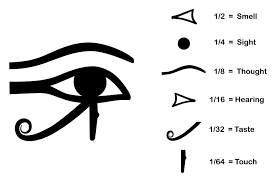
Amun = ''hidden''. 64 objective aspects. Positive/Negative?
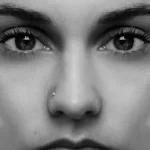 And/or: ''Sound Eye'' in relation to the 'Eye of Horus' - those sixtyfour parts that have both positive {'Sound'?} and negative {'darkness'} aspects. - the result of which = a ''Great leap'' of something {insight?}.
And/or: ''Sound Eye'' in relation to the 'Eye of Horus' - those sixtyfour parts that have both positive {'Sound'?} and negative {'darkness'} aspects. - the result of which = a ''Great leap'' of something {insight?}.
Side step: ''In ancient times the Greeks called large waves 'aig(y)es' (as jumping goats). Thus we arrive at “Aegeon” = Aegean. In modern day Greek it is called 'Aig(y)aio'....''
'Great Turning at Hand'?
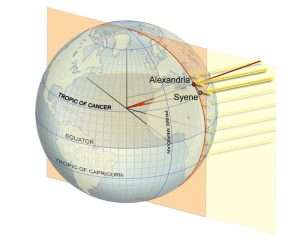 Side note: For this reader Zep Tepi is a closer analogy to what is being implied. And Zep Tepi itself {for this reader} is a closer analogy to the Hebrew 'Ain Sof' than what is normally associated with it.
Side note: For this reader Zep Tepi is a closer analogy to what is being implied. And Zep Tepi itself {for this reader} is a closer analogy to the Hebrew 'Ain Sof' than what is normally associated with it.
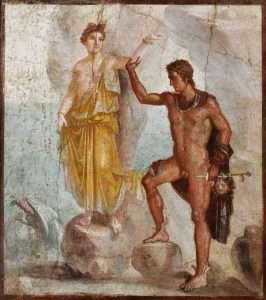
Stepping stones.
"Zep Tepi, or the First Time, was what the ancient Egyptians called that moment when Egypt first rose up out of the cosmic abyss. Zep Tepi was the moment when the river that had inundated the land began to recede and the first hillock of land became visible. That story is retold each year in the temples when the Nile flood covered the land with its fecund waters and slowly receded, marking a time of planting seeds and renewal. The story of creation from light unfolds daily, as the sunlight passes from pillar to pillar throughout the hypostyle hall at Karnac. The story of creation also repeats itself through the aeons...Temples built on top of other temples arise from the "seed stone" of previous temples." [Page 177/8 'Invoking the Scribes of Ancient Egypt'].
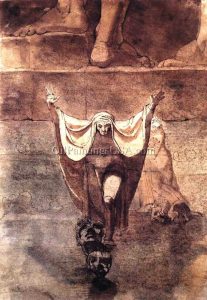
Virgil by Fuseli. Hands instead of claws. Raised hands. Twin horns? 'V' or 'W'? Shadow in relation to light. Higher/lower. Question. Right or left leg forward?
As seen from a different perspective - A work in progress? {the first one?}: "A trawl of the Iliad for references to Helen {wife to King Menelaus of Sparta} - reveals she is the the twin sister of Clytemnestra, wife of King Agamemnon {Greeks}. To locate Helen in the sky, a search began for two stars of similar magnitude to represent the twin sisters Helen and Clytemnestra, with their positions in the skies relatively close to those of their husbands, Menelaus {Scorpius} and his brother, Agamemnon {Leo}. Libra provides just such a constellation with two bright stars of almost identical magnitude, or twins... Libra is also within the zodiac close to both Scorpius and Leo. Although in modern times they are two separate constellations, Libra and Scorpius were once united in one large constellation, with the stars of Libra being known as the Claws of Scorpius. Exactly when the Claws were split off to form a separate constellation is not known, but the division of the larger constellation has echoes on Earth in the split between Helen and her Menelaus when she was abducted by Paris...Helen survives the Siege of Troy and, in the Odyssey, returns to live with Menelaus; Scorpius and Libra once more live harmoniously as neighbours in the heavens." ['Homer's Secret Iliad']. Try ''claws'' then ''Libra'' {if only to understand something in the Egyptian 'sense of the word'}.
Top/down - bottom up. Which and why?
Side Note: "Saturn is exalted in Libra. From what we have explored so far, does anyone have an idea about why this is so, and what it might be referring to?"
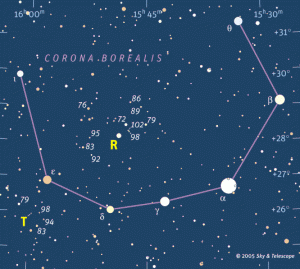 And/or: Recall the trickster character who 'stole' fire {spirit?} from 'heaven'. While Paris 'stole' Helen {Soul} from the {lower} regions? Something of the 'lower' ATTRACTED to the 'higher'. {Using the unconscious and conscious aspects as a ''start point'' i.e., willing / unwilling participants}. Top/down. Bottom/up {or would that be vice-versa}. All as a means....?
And/or: Recall the trickster character who 'stole' fire {spirit?} from 'heaven'. While Paris 'stole' Helen {Soul} from the {lower} regions? Something of the 'lower' ATTRACTED to the 'higher'. {Using the unconscious and conscious aspects as a ''start point'' i.e., willing / unwilling participants}. Top/down. Bottom/up {or would that be vice-versa}. All as a means....?
And/or: Merlin who ''came from the east and stole the stones from the west {Ireland?].

American or UN-American? "They couldn't RIG THE BIG." Good or bad everlasting karma?
"Wisdom is a flower from which the bee its honey makes and the spider poison, each according to its own nature." [Chapter 2, 'Alchemists Handbook' by F. Albertus]. Link to the word ''chakra'' and/or ''karma''.
Chakra in relation to wisdom in relation to a learning curve - ANY learning curve. Representational of. The only difference is - this learning curve [i.e.,subject] involves something other than the physical world, i.e.,'B' and 'C'. Possibilities of.
"It takes two, a positive and a negative, to make an efficient functioning psychic unit." [ Enlarged elsewhere - to understand the whole]. Link to ''equilibrium''. Purpose and benefit of. Representational of.
''The whole gamut of human experience {and/or emotions}''. Question. What animal represents that final word? ...Why?
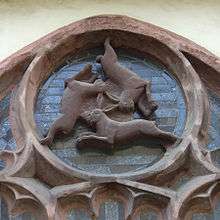
Man in the moon? hare?
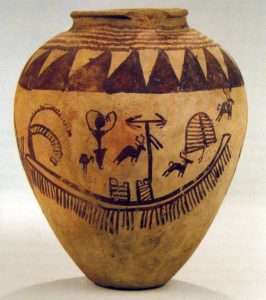
The Rump is part of the Arabian megaconstellation of the Lion (al-asad). It lies well south of the rest of the Lion, so it may have been a later addition to the figure.
"Again, the moon man ever attends upon the moon goddess who sails in the 'ship of life'. It is often forgotten that it takes two to make a pair, for the sphere of manifestation is the sphere of duality, and while we are in these realms of duality it takes two to complete the functional unit, whether that unit is in the sphere of generation or in the sphere of intellection. There is always the subject and the object, the within and the without, the subjective and the objective." [Quote from within the book 'The Forgotten Mage'].
'On Having No Head: Zen and the Rediscovery of the Obvious' / D. E. Harding.
"...the 'nails' of objectivity - which give conscience to thought."
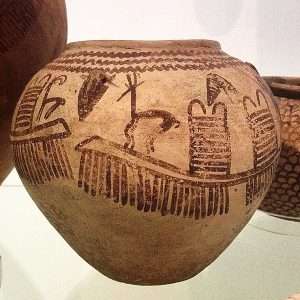
A leap across a gap?
The symbol of which is the Crown of Thorns, i.e.,"The 'thorns' of the crown center function as the 'nails' of objectivity..." [Taken from 'letter 5' from within the book by Tomberg].
'Queen of Thorns'?
Before those first impressions take hold; remember that Christ himself also understood the same subject; and, by way of - the same method?
That ''duality'' that can be represented as {examples of}: King/Queen and/or Thorns/Roses, i.e.,'petals' {flowers?} and/or Dark/Light and/or Bitter/Sweet and/or Spotted/ Unspotted and/or Redeemed/Unredeemed and/or Lucky/Unlucky and/or Ebb/Flow and/or Waxing/Waning and/or Separate/Union and/or Shield/Cup and/or Circle/Square and/or Line/Arc and/or East/West and/or North/South and/or Womb/Tomb and/or Death/Rebirth etc.
ALL AS A MEANS....?

objective or contrived? Recall Syria to name but one.
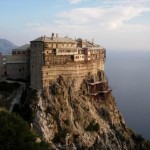 "...for everything that takes place in subjective intimacy will one day become objective reality. It is the 'magical' law of history that the subjective at some time becomes objective; that the aspirations, thoughts and feelings of today become the events of history tomorrow." [Extract from the book by Tomberg]. Link to the word ''hindsight''. Benefit of, i.e.,understanding the past, gives us an [idea?] as to who or where we are in the present: 'past' together with 'present' = idea of future? Think on it relative to the contents of a subject - together with the same word as mentioned in Part 1.
"...for everything that takes place in subjective intimacy will one day become objective reality. It is the 'magical' law of history that the subjective at some time becomes objective; that the aspirations, thoughts and feelings of today become the events of history tomorrow." [Extract from the book by Tomberg]. Link to the word ''hindsight''. Benefit of, i.e.,understanding the past, gives us an [idea?] as to who or where we are in the present: 'past' together with 'present' = idea of future? Think on it relative to the contents of a subject - together with the same word as mentioned in Part 1.
'On Having No Head: Zen and the Rediscovery of the Obvious' / D. E. Harding.
REFRESHER..."The serpents are universal symbols for the creative powers of the feminine. In esoteric psychology and physiology they represent the kundalini - the serpent power...The force - in the words of Dylan Thomas - 'that through the green fuse drives the flower' - the generative {representational of} - the powers of life. It is essentially a feminine force {anima?}, and thus is not easily comprehended or come to terms with by the masculine dominated intellect {'shadow' and/or 'spirit?}." Extract from the book by G. Knight. Link to {the study?} of ''equilibrium'' and/or ''balance'' - purpose of. Benefit of. REPRESENTED {if only in this subject} - with/by ''twins''.
"...it is thus not easily comprehended by the..." = Shadow versus light {and/or anima}?
Therefore in its more {abstract?} form = the Garden {''green''?} of Eden story?
Question. What symbols {keys?} would represent that {struggle?}.
N.B. 'The Green Snake and the Beautiful Lily'. And/or 'The Tale of the Shipwrecked Sailor'.
Analogy of same; in its most basic form....The process of a learning curve {'arc'?}. Regardless of subject.
 "There may well be useful parallels to be drawn between analytical psychology and magic, one with its approach to the Unconscious, the other to the Anima Mundi or the 'astral light', but such terms are not necessarily completely interchangeable. We must be beware of substituting one set of ill-understood and inadequate terms for another set - thinking that we are gaining great wisdom thereby. Try ''peacocks tail'' for a further head-scratch.
"There may well be useful parallels to be drawn between analytical psychology and magic, one with its approach to the Unconscious, the other to the Anima Mundi or the 'astral light', but such terms are not necessarily completely interchangeable. We must be beware of substituting one set of ill-understood and inadequate terms for another set - thinking that we are gaining great wisdom thereby. Try ''peacocks tail'' for a further head-scratch.
'By endurance we conquer'. Ernest Shackleton. Try 'Struggle''.
Refresher: ''Where good deeds are ships on which to ride the waves."
'The highs don't last forever, but then neither do the lows'.
Ebb and Flow? and/or Ascent/descent?
"Error runs down an inclined plane, while truth has to laboriously climb its way up hill".
A {practical} example: ''The road ahead will be long - the climb steep.'' [Election victory speech/ Barack Obama].
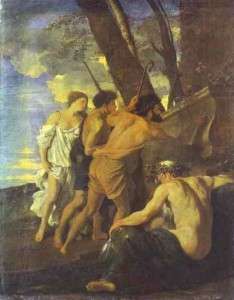
The Latin poet Vergil [70 B.C] wrote in his work the Ecolques, about the pastoral Arcadia. The influence of Vergil in establishing Arcadia as a poetical ideal still resonates in arts and literature. [www.et-in-arcadia-ego.com]. Arcadia surrounded by mountains. The older of the two paintings. Both of which - on the flank of a mountain. Left to right, as opposed to right to left. The female aspect, being the start point on both. 'Younger' in relation to 'elder'. Higher in relation to lower - i.e., as a practical example - in breaking old habits? Beginnings of. Anything? See Part 1.
"In Ancient Greek, Logos had many meanings, but non of them is ''Word,'' which is based on a translation of a translation. When the Greek New Testament was translated into Latin, Logos became Verbum; and when the English King James translation was made from the Latin version, Verbum became ''Word,'' twice removed from the original text''................."Among its many [true] meanings, Logos designates the power of ''reason,'' the pattern or order of things, the principle of relationship, and an organized articulation of something.".............."Logos has the same meaning as both the Latin words 'ratio' and 'oratio'. Ratio is the principle of Reason in its many senses, yet it is also ratio in a mathematical sense, as in continued geometrical proportion.

Side note: "Things like Google Translate can match the hidden patterns between different human languages and translate them....AI tools can find these invisible patterns that we cannot see and link them to patterns between languages....It finds the shapes of certain phrases - from billions of data - without the need of a dictionary. It does not even know that it is dealing with a language." ['Royal Institution Xmas Lectures' / 2023].
Could it be used someday for a mindset - within {say} a curriculum?
Oratio is a discourse, an articulation, a setting forth of the ''ratio,'' or nature of things. Logos, as a principle, is the natural order of things, the principle of reason, relation, and harmony, which exists both within the natural fabric of the universe and within the human mind. It is the faculty whereby one thing is related to another through analogy, or the power of ''proportional insight.''........
'Mans Search for Meaning' / Viktor Frankl.
"If we are to appreciate the Prologue to the Fourth Gospel and other 'mystical' writings, all of these meanings must be 'simultaneously' held in mind." [Chapter 3, 'Jesus Christ Sun of God'. Mentioned elsewhere]. i.e.,in the sense - of an objective exercise; by way of; those three universal principles. Get it? If not try [revise] Part 1.
'On Having No Head: Zen and the Rediscovery of the Obvious' / D. E. Harding.
"This stepped incline is called the Staircase of the Dead - not merely because it is dark, and because their are tombs [or sarcophagus. This readers input], at the bottom, but because all those who climb towards the zodiacal arch at the top are deemed to be the sleeping dead. It is only when they have passed through the arch of constellation images, and have stepped into the light filled courtyard, that they may be regarded as having entered into the land of the living. Of course, this transition is entirely symbolic, yet it is representative of an event, which, even after 6000 years, is still shrouded in mystery. It is symbolic of initiation." [Prologue, 'The Zelator'. Mentioned elsewhere].
"Initiation is not a ceremony, it is the beginning of a new way of using the mind."
Enlarged elsewhere. And throughout.
Only that is - before those first impressions; dictate something else - if one does not understand the difference [and therefore benefit] - of the purpose - of being objective rather than subjective - if only in understanding something/anything.
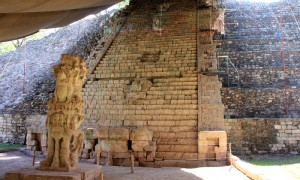
The largest Pre-Columbian stone stairway with hieroglyphs in history. The 'Motmot marker' found at its base. Representing - 'Father' and 'Son'.
"Error runs down an inclined plane, while truth has to laboriously climb its way up hill". Try Gog / Magog.
Question. Coincidence? Or a meaningful one?
Analogy with same intent..."This tradition requires an appreciation of long term narrative and consequence, dedication, patience, discipline, and above all, unassailable faith - there are many who want to fly to heaven, but few willing to climb." [Extract from the author M. Katz of the Western Way tradition].
''Patience is the mother of will. If you have no mother, how can you be born?" Gurdjieff.
REFRESHER; "Clement of Alexandria elucidates the idea that Jesus is the 'son of god' by explaining: 'The Son is the consciousness of the Father.' The 'Father' is the Mystery...the dazzling darkness of UNconscious Consciousness."
Those attributes relevant to anything that one has an interest in - especially the understanding [i.e.,the study] of ''subject'' material - as all subjects within the educational curriculum prove. With one exception however : ''unassailable faith''. Very similar [if only for this reader] to the quote often made by the presenter of the 'Ancient Aliens' satellite program ''I want to believe'' - a reminder possibly of the faith and hope within the exo-teric [flip-side] to this same subject [see Part 1]. The main point, however is - this readers main aim [and therefore this web page] - is to understand the subject for its own sake; nothing else - to understand - not through - ''unassailable faith'' or because ''I want to believe'' or even through ''faith and hope'' - - but just through the want to understand a subject - and as one does in any subject - that is best done - BY WAY OF - OBJECTIVE ANALYSIS- rather than; ritual or prayer. Enlarged elsewhere. It can be done - as proven by the contents of this web page.
Question. A mind set?
"When, through contact with his 'higher' self [link to ''teacher'' of Dead Sea Scroll fame. Enlarged elsewhere] - he participates in the knowledge of the objective, and when through the climbing of the mountain of vision his perspective changes and his horizon enlarges..." [Introduction to the book by A. Bailey]. Try ''horizon'', i.e.,what does it imply?
Karnak to enlarge.
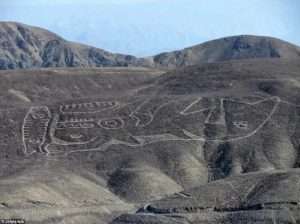
The Nazca killer whale. The most ancient one of all the glyphs. Stones for an eye. Up or down stream?
'On Having No Head: Zen and the Rediscovery of the Obvious' / D. E. Harding.
Samwell Tarly? {Game of Thrones}.
Side note: ''The man who 'moves a mountain' starts by carrying a few stones''.
Try Silbury Hill.
Continued: Apollo could therefore be described - or more importantly, what 'he' represents - as the 'sum result ' of the ''fruit of ones labors.'' He was also the protector of herdsmen and shepherds.
To' herd' and/or 'shepherd' ones 'lower' {base?} instincts/emotions? To 'enclose' them? To define them within 'boundaries'? ALL as a means to a further understanding? Look up ''Apollo''. Then try ''means''. Purpose of.
"The 'Great Work', as an ideal, is therefore the state of the human being who is in peace, alliance, harmony and collaboration with life. This is the ''fruit'' of the Tree of Life." [Quote taken from the book by Tomberg]. ANYTHING?
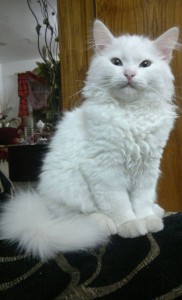
Kunkush - alias 'Zeus' found on the island Lesbos.
Example of..."Interesting stories have been minutely recorded by Greek historians and others who accompanied or followed after Alexander in his expedition to India. The narratives of Arrian, Diodoros, Plutarch, and Strabo the geographer have been translated by Dr. J. W. McCrindle to throw a shaft of light on ancient India. The most admirable feature of Alexander's unsuccessful invasion was the deep interest he displayed in Hindu philosophy and in the yogis and holy men whom he encountered from time to time and whose society he eagerly sought. Shortly after the Western warrior arrived in Taxila, in northern India, he sent Onesikritos {a disciple of the Hellenic school of Diogenes} to fetch the great sannyasi of Taxila, Dandamis. 'Hail to thee, O teacher of Brahmins,' Onesikritos said, after seeking out Dandamis in his forest retreat. 'The Son of the mighty god Zeus, being Alexander...asks you to go to him. Otherwise {threats ensue}...The yogi received calmly this fairly compulsive 'invitation,' but not so much as lift his head from his couch of leaves. 'I am also a son of Zeus, if Alexander be such, i want nothing that is Alexanders, for i am content with what i have, while i see that he wonders with his men over sea and land for no advantage, and is never coming to his end of wanderings. Go and tell him that the Supreme king is never the author of insolent wrong, but is the creator of light, of peace, of water, of life of the body of man...How can Alexander be the worlds master, when he has not yet seated himself on a throne of inner universal dominion..." [Extract from the book 'Autobiography of a Yogi'. Mentioned elsewhere]. Try 'wandering''.
Link to ''son of'' its true universal meaning; not its most obvious one. Alexander only understood this subjects ''lower'' stuff, i.e.,in part - not whole. In other words he became more subjective with what he did know - than objective. He really did 'see' himself as a ''god''. Think on it. How simple yet profound. Other information enlarged elsewhere.
"The destiny of man, as we have said, is to make or create himself. He is, and he will be the 'son of' his works, both for time and eternity." Quote by E. Levi.
"AND the greatest idolatry of man is the creation of a god in his own image." ['Journey into the Light'].
Side note: Question. Cro-Magnon man in relation to Neanderthal man - which understood 'objectivity' {and all its benefits} - first? Or does it matter?
'On Having No Head: Zen and the Rediscovery of the Obvious' / D. E. Harding.
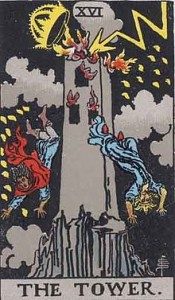
In the 'intellectual'' sense of the word?

Contraction or expansion?
Analogy?: "The universe and everything within it constitutes 'god'. The universe is a gigantic human organism and man is a tiny image of it, a toy replica of god. Because he is a miniature of the universe, by a process of spiritual expansion a man can mystically extend his own being to cover the entire world and subject it to his will. It is because all things are aspects of the one thing that all things are grist to the magician's mill...He has reached the center, where man becomes god. The achievement of this is the Great Work...It will be apparent at once that 'fallen' man, convinced of the truth of such a theology and fired with desire to wind himself up to 'Godhead', can develop into a demonic personality very quickly indeed. The assaults upon a full-blooded 'magician's' integrity are dreadful to contemplate." [ Book by A. Duncan].
"The Kingdom of Heaven is within you. The time has come for external forms and expressions to be left behind. There is no Temple in the heavenly Jerusalem, for religion has no place in Heaven. Man is his own Temple. A mans heart is the altar of god...." [First chapter,{'The inner Quest'} from the book 'The Mind of Christ' {Meditations on Christian Themes} by Anthony Duncan].
House Baratheon? {Game of Thrones}.
Analogy of same...'Who Is in My Temple' AND 'In The Temple of Silence' ['Cosmic Chants' by Paramahansa Yogananda].
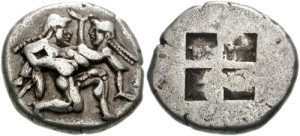
An ancient Greek coin, depicting both Nymph and Satyr. Both found in valleys and on mountains. A union of the two. Its most fundamental form. ''The full grown larva of bees just before they emerge from their cells are called nymphs...'' [From the book, The Sacred Bee]. Once again a REPRESENTATION of something, other than the obvious. Can you see what that something is? Clue. Put ''bee'' in the usual box. In all pages. [Hard work isn't it?].
That link to Dionysus of whom both Apollo and Artemis are 'related,' in some 'form' or other. 'Shadow' in relation to 'light.' That subject again. Understanding that link between 'subject' and the 'divine bit,' explains why it is used by countless authors as its primary principle, relative to an understanding. [Chapter 9, 'The Sacred Bee']. Other examples relative to the ''unconscious'' aspect. Pan in relation to Zeus. Nymphs in relation to both Zeus and Apollo, but Satyrs a link to Dionysus.
Khal Drogo? {Game of Thrones}.
"Perhaps in this way we shall attain the high philosophical goal of perceiving how the divine life in man is joined in all innocence with animal life." [Quote by Goethe. Taken from the inset pages, i.e.,first quote; first paragraph of the book by C. Kerenyi].
'Becoming Animal: An Earthly Cosmology' / D. Abram.
 "Human experience does not always give rise immediately to ideas. It can be reflected in images or words without the mediation of ideas. Man reacted inwardly to his experience before he became a thinker. Prephilosophical insights and reactions to experience are taken over and further developed by thought, and this process is reflected in language." [Intro to the book 'Dionysos: Archetypal Image of Indestructible Life' by C. Kerenyi].
"Human experience does not always give rise immediately to ideas. It can be reflected in images or words without the mediation of ideas. Man reacted inwardly to his experience before he became a thinker. Prephilosophical insights and reactions to experience are taken over and further developed by thought, and this process is reflected in language." [Intro to the book 'Dionysos: Archetypal Image of Indestructible Life' by C. Kerenyi].
Question. At what stage of the evolution of human experience [subjective/objective link] did man/woman first begin to 'see' inwardly? If ''images'' came before ''ideas'' and therefore the ''process of thinking'' - what exactly is being defined in relation to those ''images''? And/or which came first and why? Question 2. Is that process still ongoing. Or have all the alternative answers [for 'each' image] been found? Relative to each individual.
Side note: Cro-Magnon man in relation to Neanderthal man. Many wonder why one outlasted the other. Question: Which understood 'objectivity' {and all its benefits} - first? Or does it matter?
"...to turn the clock back 25,000 or 50,000 years in order to join the presumed moment when an anthropoid opened the path toward a Homo sapiens capable of coordinating his thoughts...As to the history of the origin and becoming of thinking man..." ['Sacred Science: The King of Pharaonic Theocracy' / R. A. Schwaller de Lubicz].

By way of the minds eye?
Something hunted at: ''Conventional history puts little emphasis on the evolution of consciousness, but we can see it in action within the changes of Greek drama....Plays by Aeschylus and Sophocles were the first to be performed outside of the Mystery schools....In conventional history it is assumed that people have always been pricked by conscience. On this view , Euripides was the first person to put a name to it: There is only one thing that can survive all life's trials - a quiet conscience {i.e., in relation to a 'guilty' one}.....The reason there is no suggestion of conscience in any of the annals of human experience up to that point, is that the Eleusian Mysteries forged this new dimension of human experience.....It shows us new ways of being - feeling, thinking, willing, perceiving. To borrow a phrase from of Saul Bellow's, it opens the human condition a little wider." [Page 269 'The Secret History of the World'].
Blacksmith?

To prick ones conscience?
"Isn't it a childish game to deify natural fact?' asked Abushed. 'We deify nothing,' corrected the sage. ' But we know that Neter is before man, idea before thing...Isn't a Neter a manifested quality? One ascends from nature to Neter, through whose symbols one may get to know nature." ['Her-Bak'].
Unmanifested?
Follow the title of the book to 'see' it from the Egyptian {idea?} of something {perspective?}.
Side note: ''The 'flag' as a symbol of the presence of any ''divine'' being - god or goddess - harkens back to one of the oldest goddesses, Neith, the weaver. Her name in early hieroglyphs was written as N-t, and it meant ''the goddess.'' Subsequently, N-t-r became any god or goddess. N-t in hieroglyphs also is part of the word meaning ''to knit'' or ''to weave'' or ''to net'' {'153'?}....In Alexandria, the cosmopolis of ancient cultures where many languages merged, the ancient Egyptian word neter and the Coptic Christian word for ''the god'' came to be pronounced something like netjer; from this, the essence of the Latin word for NATURE, natura, emerged....the early Christian name for 'God'...." [Page 35 'The Union of Isis and Thoth' / N. Ellis and N. Scully].

Ebb and flow?
Analogy: "From references within the Pheryllt Material, as well as countless other historical sources, we know that the Druidic system of 'magic' revolved around a reflection {unmanifest?} of natural cycles clearly visible in nature. Some of the most important of these were: the cycle of death and rebirth; the seasonal cycles of rotation; the circular movements of the sun, moon, planets and constellations; the ebb and flow of the ocean tides, and the migration of birds and beasts....In order to validate their teachings, beyond mere man made imaginings, the Druids were careful to base all their key doctrines after patterns easily observed in the natural realms around them - to certify them as if by divine imitation. To them small things - a flower, a pebble, a snowflake, the path a salmon takes in the water - were reflections of the Great Cosmic Order; glimpses into the mind of god, and were therefore worthy of great study, reverence and replication." [Page 35-37 from the book by Douglas Monroe].
Anything? or just coincidence?
Think about all {especially ''divine imitation''} in relation to that universal ''bit'' - in the INNER sense of the word - if only in defining a MIND SET.
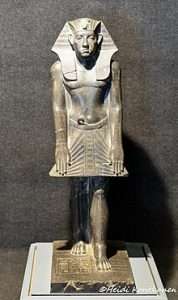
Upright?
A working example: All art was drawn to strict guide lines on a grid pattern. The earliest grid for an upright man measured 'eighteen' squares from the sole of his foot to his eyebrow – the scale of one square was determined by the closed fist. The primeval sun god Atum created the universe by onanism. It was by Atum making love to his fist that the Egyptian elements were conceived – Shu (air), and his consort Tefnut (water),who begat Geb (earth), and Nut (sky).
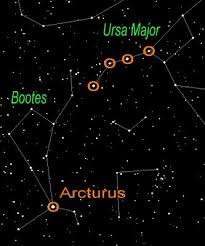
Herdsman or ploughman. Ploughshare?
''An article entitled An Enigmatic Bird from HK25 (Pyke and Colman 2006, 6) described a picture carved over 5,000 years ago on a sherd of red-polished pottery after it was fired. This is a sketchy picture of the Northern Bald or Hermit ibis (Geronticus eremite), a migratory bird which inhabits desert cliff tops and which the Bedouins call ‘ An-Nuq’ (Yosef, personal communication, January 2007).The bird was known in Egypt throughout the pharaonic period. Sadly today it is a ‘critically endangered’ species with decreasing numbers returning annually from their wintering grounds in the Ethiopian Highlands to the tiny breeding colony in Syria in the spring (Balmer andBetton 2007, 126).The discovered sherd also has an inverted V-shape placed at a diagonal pitch above and to the right of the bird (Figure 1). At a casual inspection, this 'V formation’ looks like a wishbone or a crude compass rather than a hieroglyph. As religion and language are thought to have been in their infancy at this time, both these crude etchings are reminiscent of the syllabic signs or biliteral hieroglyphs, G25 and U8 (using the standard of Gardiner’s sign list). U8 is generally thought of as U6, the agricultural 'hoe’, but missing the rope connecting the two pieces. From the beginning, the hoe hieroglyph seems to have two different sound values – ‘Hn ’ or ‘mr’ – and unrelated meanings which have yet to be explained.
A work in progress: ''By comparing the sign combination of other ceremonial palettes, such as Libyan {cities} Pallete and the Battlefield Pallete, Goldwasser shows that the Narmer Pallete had evolved metaphors to a complex and sophisticated use....He does not address the 'hoe' they are holding, which has been interpretated as the founding of these cities by one, or many, rulers.'' ['One Pallete, Two Lands: The Myth of the Unification of Egypt by the Narmer Pallet' / Scott Allan ].
'Hoeing the Fields' to enlarge.
''Ploughing''?
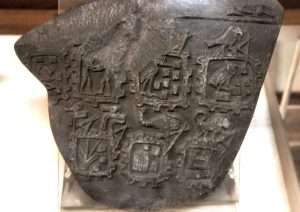
'Three and four'?
''The Libyan Palette (also variously known as the City Palette,[1] the Libyan Booty Palette, the Libyan Tribute Palette, the Siege Palette, the Tehenu- or Tjehenu Palette) is the surviving lower portion of a stone cosmetic palette bearing carved decoration and hieroglyphic writing. It dates from the Naqada III or Protodynastic Period of Egypt (c. 3200 to 3000 BC). The palette was found at Abydos, Egypt....The palette is made of schist and it is 19 cm long and 22 cm wide.[2] Housed in Room 43 on the ground floor of the Egyptian Museum, Cairo,[3] its Journal d'Entrée number is JE27434 and its Catalogue Général number is CG14238.
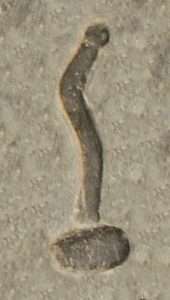
Closed 'fist' ?
On one side, there is a scene of walking lines of animals within registers.[4][5][6] Below these animals, an orchard with olive trees is depicted, and the hieroglyphic inscription thnw or tjehenw (usually transcribed as tehenu), most likely a toponym of Western Nile Delta or, according to most scholars, what was later associated with Libya.
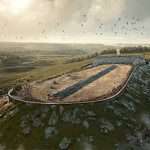
"The first of its kind."
The character consists in the throwing stick on top of an oval, meaning "region", "place", "island", a toponym of Libya or Western Delta pronounced THnw, Tjehenw."
Side note: "Libyan desert glass or Great Sand Sea glass is an impactite, made mostly of lechatelierite,[1] found in areas in the eastern Sahara, in the deserts of eastern Libya and western Egypt. Fragments of desert glass can be found over areas of tens of square kilometers."
"Hypatia is a small stone found in Egypt 1996. It has been claimed to be both a meteorite[1] and kimberlite debris[2][3]. It has also been claimed to be the first known specimen of a comet nucleus on Earth, although defying physically-accepted models for hypervelocity processing of organic material.
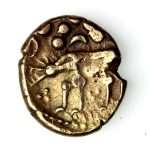
Teeth for a 'key'?

'Spirit' or 'Soul'? Male or female feet.
As of November 2023, Hypatia has not been officially classified as a meteorite in the Meteoritical Bulletin, which is tasked with recording all scientifically proven meteorites. The rock was named after Hypatia of Alexandria (c. 350–370 AD – 415 AD) – the philosopher, astronomer, mathematician, and inventor.[7] Assuming the Hypatia stone is a meteorite, such naming is in violation of the long-standing convention and regulation of naming meteorites, which states that "a new meteorite shall be named after a geographical locality near to the location of its initial recovery"
''As a single number NINE is the highest in value.''
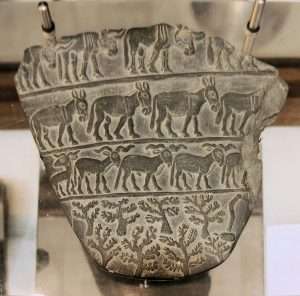
Bottom-up or top-down?
Continued: ''The opposite side of the Libyan Palette shows the feet of some persons above a register line. Under the register, seven fortified towns are depicted, with the name of each town written within the wall. Above each town, an animal grasps its wall with the mr (hoe) hieroglyph.[5] Günter Dreyer has interpreted this scene as a scene of destruction and the animals, or animal standards, as royal names.[1][4][8] However, other scholars have suggested that the animals represent royal armies or symbols.[1] Another completely different interpretation is that the scene represents the foundation of these cities.''
''Cosmetic palettes are archaeological artifacts, originally used in predynastic Egypt to grind and apply ingredients for facial or body cosmetics. The decorative palettes of the late 4th millennium BCE appear to have lost this function and became commemorative, ornamental, and possibly ceremonial. They were made almost exclusively out of siltstone with a few exceptions. The siltstone originated from quarries in the Wadi Hammamat.
Animal, mineral or plant pigments?
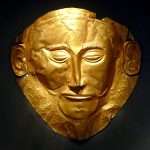
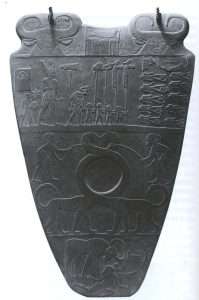
Narmer Palette.
Many of the palettes were found at Hierakonpolis, a centre of power in pre-dynastic Upper Egypt. After the unification of the country, the palettes ceased to be included in tomb assemblages. Siltstone was first utilized for cosmetic palettes by the Badarian culture. The first palettes used in the Badarian Period and in Naqada I were usually plain, rhomboidal or rectangular in shape, without any further decoration. It is in the Naqada II period in which the zoomorphic palette is most common. On these examples there is more focus on symbolism and display, rather than a purely functional object for grinding pigments. The importance of symbolism eventually outweighs the functional aspect with the more elite examples found in the Naqada III period, but there is also a reversion to non-zoomorphic designs among non-elite individuals.''
'Face to face'?
And/or: ''On the outskirts of the town center of Hierakonpolis stood the semi-subterranean dwelling of a potter who burned his house down with his own kiln (HK29), thus insuring its fine preservation down to the charred roofing timbers and wall beams, found in 1978 just as they had fallen 5500 years earlier. While up the wadi, out in the suburbs, excavations within a roomier estate (see HK11: Settlement features) has revealed a variety of domestic features including hearths, storage pits and food preparation areas enclosed by a fence that still retains its mud-coated reed matting after all these years.
Pot-making appears to have been a growing occupation in the Predynastic period. Stratified deposits within the HK11 house show a rather rapid change from the home-make cooking pots used earlier to the relatively inferior (straw tempered) product that was mass produced at the time of the city’s peak by the potter at HK29 and elsewhere. Others specialised in making the fine polished red and black-topped red vessels, characteristic of the Naqada I and early Naqada II phase of the Predynastic and some of the finest pottery ever made in Egypt. Production sites for this type of pottery were tucked away in the cliffs lining the great wadi (HK59 etc), possibly to keep secret the specialized knowledge needed for its manufacture. The piles of cracked, over-fired and melted pots which identify these production sites indicate that much skill was required to form, dry and fire these elegant thin-walled vessels and that it was not easy to master.''
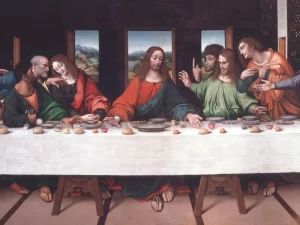
V shape. 'ONE degree'? Window pillar between the two red 'shoulder' colours. M/F? Body of 'water' either side. 'Stripes' on the floor base. 'Linen' cloth for table {'altar'} top. Wool or cotton for garments? Sheep decan?

The fifty stars on the flag represent the 50 U.S. states, and the 13 stripes represent the thirteen British colonies that declared independence from Great Britain. ''Spots'' = N/W?
Astronomers have long used finger and hand measures to estimate angular distances between stars. The London Papyrus 130 Neugebauer and van Hoesen, 1959, locates Jupiter in Cancer: ‘two fingers north of the Bright Star’. The extended arm with a closed fist marks off 10 degrees. Thus at eye-level, projecting the extended arm and noting the fist to be10 degrees and doing a spin around, a man’s world is calculated to be the equivalent of 36 fists. On the circle, 10 degrees is one decan.
Side note: Bacteria attacking the oil paint of the Last Supper. Same process attacking the paint work in the tomb of Tutankhamun with ONE exception. It was a WET surface in the case of Tut. But a DRY one in the case of the 'Last Supper'.
''Queendom'' to enlarge.
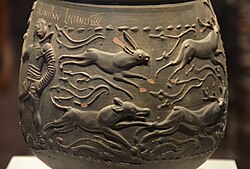
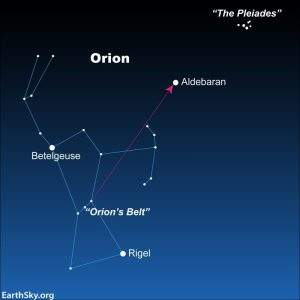 Side note: The Colchester Vase is an ancient Roman British vase made from local clay from Colchester, England, dating to 175 AD, depicting a gladiator battle between two individuals: Memnon and Valentinus, which are believed to be stage names.[1]
Side note: The Colchester Vase is an ancient Roman British vase made from local clay from Colchester, England, dating to 175 AD, depicting a gladiator battle between two individuals: Memnon and Valentinus, which are believed to be stage names.[1]
It was discovered in a Roman-era grave in 1853, which held the deceased's cremated remains.[2]
It is currently held in the Colchester Castle Museum collection, and is renowned as one of the finest pieces of Roman-British pottery in existence.[1][2][3]Initially presumed to be an imported object, thanks to the sophistication of the figures on the vase, a 2023 analysis of the vase indicates a local origin. The vase demonstrates the extent of gladiatorial combat on the outskirts of the Roman Empire. The text on the vase was etched in while the clay was soft before the vase was baked in a kiln.[6]
The vase derives either from Durobrivian or Castor Ware.
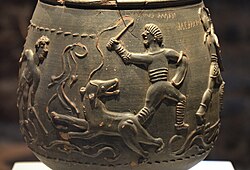
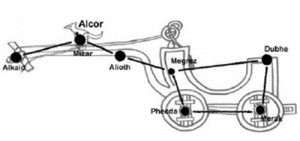
In North Germany Alkor, Hans the Thumbkin, — the legend being that Hans, a wagoner, having given the Saviour a lift when weary {'153'?}, was offered the kingdom of heaven for a reward ; but as he said that he would rather drive from east to west through all eternity, his wish was granted, and here he sits on the highest of the horses of his heavenly team. Another Teutonic story was that their giant Orwandil, our Orion, having frozen one of his big toes {left?}, the god Thor broke it off and threw it at the middle horse of the Wagon. where it still remains.
Roman Colchester (Colonia Claudia Victricensis), or Camulodunum, is famous as a center of pottery production during the 3rd century, with 40 documented kilns in the town.[7]
The jar is decorated with three different scenes, relating to the different recreational activities common at the time.[3] The inscription on the vase reads:'Secundus (and) Mario'/'Memnon the secutor (victor) nine (times)'/'Valentinu(s) of the Thirtieth Legion'[3]
The first scene depicts animal-animal fighting, with a dog chasing two deer and a hare.[2][9]
The second scene depicts the bestiarius, the animal hunting spectacle, with venators named Secundus and Mario fighting a bear.[3] Mario is a dative of "Marius"; the location of the names do not specifically tag or identify the beast-fighting figures.[9]
'Thirty'?
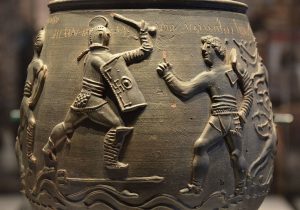
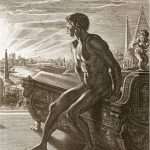 The second scene depicts the gladiator battle of two men: Memnon, a secutor and Valentinus, a retiarius.[2] The text identifies Valentinus as a member of the Legio XXX Ulpia Victrix, though it is noted that the Legio XXX was not based in Britain, but rather in Germania Superior, in present-day Xanten.[3][9][10] Memnon is labelled as the victor of the match, with "VIIII" indicating this is his ninth victory, with Valentinus depicted as raising his finger in defeat.[2] Memnon, a reference to the mythical Ethiopian king in the Trojan War, is believed to be a stage name for the winning fighter, and also extant evidence of Roman residents of African descent in the area.[6]
The second scene depicts the gladiator battle of two men: Memnon, a secutor and Valentinus, a retiarius.[2] The text identifies Valentinus as a member of the Legio XXX Ulpia Victrix, though it is noted that the Legio XXX was not based in Britain, but rather in Germania Superior, in present-day Xanten.[3][9][10] Memnon is labelled as the victor of the match, with "VIIII" indicating this is his ninth victory, with Valentinus depicted as raising his finger in defeat.[2] Memnon, a reference to the mythical Ethiopian king in the Trojan War, is believed to be a stage name for the winning fighter, and also extant evidence of Roman residents of African descent in the area.[6]
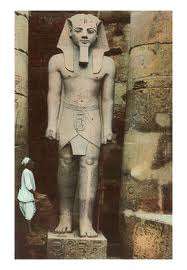
Best foot forward.
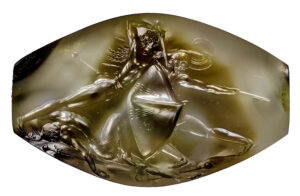
Minoan: Griffin warrior seal stone. Figure of eight shield.
From left to right: Firstly, two animal hunters (bestiarii/venatores), named Secundus and Mario, fight a bear. Secundus is barely clothed and holds a cudgel in each hand. Mario is better armoured, with leg and arm guards, and brandishes a whip at the bear that has turned its head towards him. In the next scene a pair of gladiators are depicted. Memnon, a well-armoured secutor gladiator, fights with a sword (gladius) and shield and wears the distinctive, encasing helmet. His opponent is Valentinus, a retiarius gladiator, identifiable by the trident (tridens or fuscina) which he has dropped to the ground, although he has lost his net (rete). He is lightly armoured with a padded arm sleeve (manica), his main protection being a distinct, tall metal guard on the left shoulder (galerus), which acted like a shield. Valentinus raises his index finger (ad digitum) signalling his defeat. Valentinus may have been at a disadvantage in that Memnon is depicted as left-handed (scaeva), one of only two depictions of such a fighting style known from Roman Britain. In the final scene of the pot’s decorative frieze, a hunting dog is shown in pursuit of two stags and a hare. The names of all the figures are specified in an inscription that runs around the top of the pot, below the rim. This inscription was cut onto the pot as it was being made (pre-firing). It records that this was Memnon’s ninth victory as a gladiator and that Valentinus was of the Thirtieth (XXX) legion in the Roman army. This last piece of information presents a puzzle as the Thirtieth legion was never stationed in Britain.
Refresher: "A grove is a community of Druids. Many non druidic pagan groups use this term as well. In some Wiccan traditions, groups of thirteen and under are known as covens, but once the group goes beyond 13 members, its called a grove.'' [Page 65 'Idiots Guide to Paganism' ].
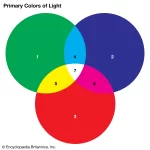
Whats the primary colour for M/F? NOT the secondry i.e., outer 'garment'!
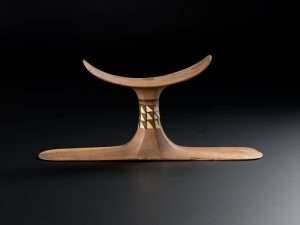
In 'three' pieces. 24 sections. Made of ivory.
Continued: ''The picture of the Last Supper commissioned for the monks dining room in the Monastery of Santa Maria Delle Grazia in Milan - can be viewed for 'fifteen' minutes only. It can only be approached through a system of AIR locks. Its more like a hospital protecting the patient from contamination. The stage management of the entrance and exit is very important. Because this is a deliberately dramatic work of art.'' ['Da Vinci: The Lost Treasure' / BBC4].
''Corridor'' to enlarge.
N.B. A wooden cornice ajoining the ceiling can be seen above the painting in a 'M' shape.
Cassiopeia to enlarge.
That universal mindset in play?

Frieze_of_Imdugud_Anzu_grasping_a_pair_of_deer_from_Tell_Al-Ubaid. Question. Who was out hunting with his dogs and got turned into a stag?
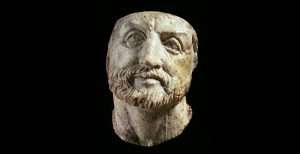
Ivory head of Phillip II who ruled for twentyfour years. Did he get his 'flowers' before he died? 'Octagon' to enlarge. AND/OR: In tomb 1 a picture of The Abduction of Persephone by Hades. Question. Was that 'wet' or dry?
Most impressive of the three tombs is Tomb II, which is usually identified as the tomb of Philip II of Macedon. It has a vaulted roof and is divided by large doors into a main room and an antechamber. The “façade gives the impression of a small Doric building,” and is decorated with an imposing, painted, hunting scene (Borza: 258). The tomb is thought to have been covered with soil while the paint was still WET and the painting is therefore not well preserved; however, outlines of most figures are still visible and detail of a few are evident. The painting portrays a royal hunt and is clearly very impressionistic as it shows more than one animal being hunted and the hunt is simultaneously at many different stages: stalking, confronting, and killing (Borza: 259). The painting shows clear similarities to the painting (now lost) that inspired the Alexander mosaic; it is possible that this hunting scene is one of the painter’s earlier works (Biers: 320).
Doric / Ionic.
Linear A/B?
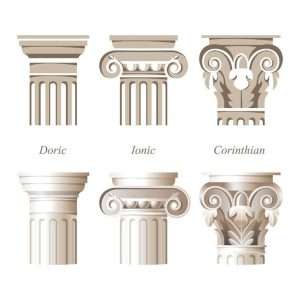
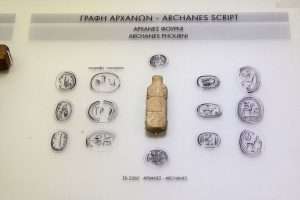 Linear A is a writing system that was used by the Minoans of Crete from 1800 BC to 1450 BC. Linear A was the primary script used in palace and religious writings of the Minoan civilization. It was succeeded by Linear B, which was used by the Mycenaeans to write an early form of Greek. It was discovered by the archaeologist Sir Arthur Evans in 1900. No texts in Linear A have yet been deciphered. Evans named the script "Linear" because its characters consisted simply of lines inscribed in clay, in contrast to the more pictographic characters in Cretan hieroglyphs that were used during the same period.[3]
Linear A is a writing system that was used by the Minoans of Crete from 1800 BC to 1450 BC. Linear A was the primary script used in palace and religious writings of the Minoan civilization. It was succeeded by Linear B, which was used by the Mycenaeans to write an early form of Greek. It was discovered by the archaeologist Sir Arthur Evans in 1900. No texts in Linear A have yet been deciphered. Evans named the script "Linear" because its characters consisted simply of lines inscribed in clay, in contrast to the more pictographic characters in Cretan hieroglyphs that were used during the same period.[3]
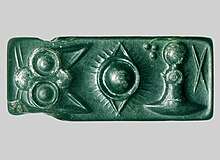 Linear A belongs to a group of scripts that evolved independently of the Egyptian and Mesopotamian systems. During the second millennium BC, there were four major branches: Linear A, Linear B, Cypro-Minoan, and Cretan hieroglyphic.[4] In the 1950s, Linear B was deciphered and found to have an underlying language of Mycenaean Greek. Linear A shares many symbols with Linear B, and they may notate similar syllabic values, but neither those nor any other proposed readings lead to a language that scholars can read.
Linear A belongs to a group of scripts that evolved independently of the Egyptian and Mesopotamian systems. During the second millennium BC, there were four major branches: Linear A, Linear B, Cypro-Minoan, and Cretan hieroglyphic.[4] In the 1950s, Linear B was deciphered and found to have an underlying language of Mycenaean Greek. Linear A shares many symbols with Linear B, and they may notate similar syllabic values, but neither those nor any other proposed readings lead to a language that scholars can read.
''The Feast of Fools or Festival of Fools (Latin: festum fatuorum, festum stultorum) was a feast day on January 1 celebrated by the clergy in Europe during the Middle Ages, initially in Southern France, but later more widely.[1] During the Feast, participants would elect either a false Bishop, false Archbishop, or false Pope.[2][3] Ecclesiastical ritual would also be parodied, and higher and lower-level clergy would change places.''

'Stamp of the feminine'? Real or symbolic? V shape? i.e., to the point of the chin which the Amarna 'period' is known for.
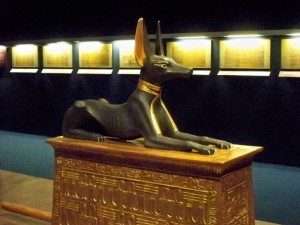
Superior/Inferior?
Continued: ''My suggestion is that the ‘V’ formation siglum on the Hierakonpolis sherd, while undeniably a prototype for the HOE tool, may also have been intended as dividers or an early compass device used by the scribal elite. For comparison argument, I bring to your mind the adze hieroglyph U19 which, in different contexts, has three different meanings. In the first instance, it is a carpenter’s woodworking tool, but it can upgrade to being a priest’s ritual instrument when utilised in the ‘Opening of the Mouth’ ceremony. Roth (1993, 70) believes it to be a ‘fallen star’ due in its manufacture to the inclusion of meteorite material. She describes the name of another adze (incidentally having star determinatives) called ‘dwn-a’ which has been translated by Otto as ‘arm outstretcher’ (Roth 1993, 67)! Starry association, whereby the adze transposes as an asterism for the Big Dipper (Ursa Major). At Hierakonpolis, (known as the ‘City of the Falcon’), pious Egyptians revered the Horus-falcon, the unblinking, eternal guardian deity of the kings of Egypt. This god, who was pre-eminent during a long attested period of worship, boasted many epithets. As ‘Horus the Red’, or ‘Bull of Heaven’ or ‘Binder of the Two Lands’ on New Kingdom and Later Period astronomical ceilings, Horus personified three of the ‘stars which wander’, namely the planets Mars, Jupiter and Saturn....
''Arcturus is Greek meaning 'guardian or keeper of the bear'. The Greeks saw this star as the guardian of Ursa Major and Ursa Minor, which are both nearby the constellation Boötes, where Arcturus is located.....Arcturus [N] [H] [S] bear-keeper, the name given by the ancients to the brightest star in the constellation Bootes. In the Authorized Version ( Job 9:9 ; 38:32 ) it is the rendering of the Hebrew word 'ash , which probably designates the constellation the Great Bear.''
And/or: ''The story behind the name: Boötes is said to be one of the most ancient constellations in the sky. There is no single definitive myth associated with this constellation, but it seems to have impressed early civilizations with its resemblance to a human torso (a kite-like shape, sometimes with legs or a raised arm)....The name Boötes is thought to stem from the Greek word for either “ox driver” or “noisy” (referring to the shouts of an ox driver or herdsman spurring on his animals). Greek mythology identified this constellation as either Icarius, the hero of the Attic deme of Icaria, or Arcas, a human son of Zeus.''
'First conscious shock'?

That new way?
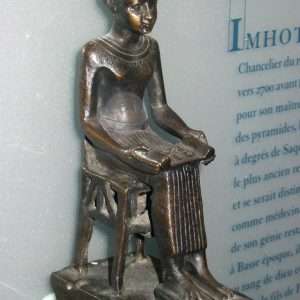
A new beginning? Method/Theme to enlarge.
And/or: In the teaching of the ideas of this system of work, it is necessary to give the work-ideas in pure form—that is, the work-ideas as originally taught must be handed on just as they were taught. This is the task of anyone who is given permission to teach the work to others. Otherwise people begin to alter the ideas a little according to their own level of understanding, with the result that in process of time they become quite different, according to each person’s prejudices, buffers, bias, and so on. In the talks about the work itself, the ideas are given in their original form. But the object of the work-ideas is to make people think for themselves by means of them, for none of the ideas of the work can really take hold of a person unless he or she begins to think about them and tries to see what they mean individually, and begins to value them and think about life and its meaning and themselves from the standpoint of these ideas. And it must be added here that no one can be different from what he is now unless he begins to think in a new way.
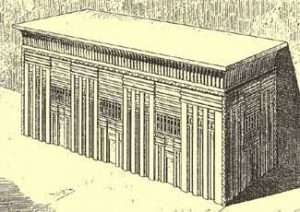
The sarcophagus of Menkaure. Any 'lid'? 'Box' to enlarge.
The work is to make us think and awaken our individual minds or what is called in this system the driver in us, which in the vast majority of people is fast asleep and remains fast asleep throughout life in spite of all troubles and disasters, one reason being that man prefers to live in the basement of himself, in the lower part of him—in the instinctive and moving centres—that is, in sensation, appetites, and muscular activity. But since the first object of the work is to make people think for themselves about its ideas and from its ideas, what are called commentaries have a place in the work....
Side note: A sarcophagus (pl.: sarcophagi or sarcophaguses) is a coffin, most commonly carved in stone, and usually displayed above ground, though it may also be buried. The word sarcophagus comes from the Greek σάρξ sarx meaning "flesh", and φαγεῖν phagein meaning "to eat"; hence sarcophagus means "flesh-eating", from the phrase lithos sarkophagos (λίθος σαρκοφάγος), "flesh-eating stone". The word also came to refer to a particular kind of limestone that was thought to rapidly facilitate the decomposition of the flesh of corpses contained within it due to the chemical properties of the limestone itself.[1][2]
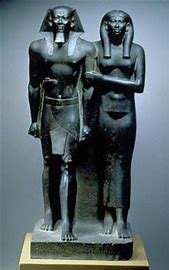
Fire and water. Spirit /Soul. Which and why?
Continued: You have often heard it said that in this work it is necessary to transform impressions {with or without a 'lid'?} - and that this is the essence of the first conscious shock, as it is called. | know that many of you do not understand the nature, in a practical way, of the first conscious shock, and simply say that it means self-remembering. But a word does not explain what it means. 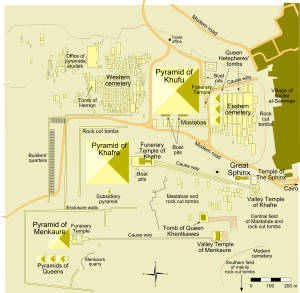 The transformation of daily life, that is, of its impact upon us, depends on understanding all that has been taught you about practical work—about self observation and work on negative states, work on identifying, and so on. It is this that insulates you. When you realize that you need not take a thing or a person in the way you are taking them, you transform something and at the same time you insulate yourself. Self remembering, nonidentifying and not-considering all help to insulate us from the influences of life. Acting consciously at a difficult moment has the same effect. Similarly, if you experience a moment of real consciousness, a moment of self remembering, you will feel that it is just as if you were insulated from life and that nothing could touch you. And such would be the case if we were always in a state of self remembering. Our task is to try to imitate higher states of consciousness, so as to attract them. {'Psychological Commentaries on Gurdjieff and Ouspensky' / M. Nicoll}.
The transformation of daily life, that is, of its impact upon us, depends on understanding all that has been taught you about practical work—about self observation and work on negative states, work on identifying, and so on. It is this that insulates you. When you realize that you need not take a thing or a person in the way you are taking them, you transform something and at the same time you insulate yourself. Self remembering, nonidentifying and not-considering all help to insulate us from the influences of life. Acting consciously at a difficult moment has the same effect. Similarly, if you experience a moment of real consciousness, a moment of self remembering, you will feel that it is just as if you were insulated from life and that nothing could touch you. And such would be the case if we were always in a state of self remembering. Our task is to try to imitate higher states of consciousness, so as to attract them. {'Psychological Commentaries on Gurdjieff and Ouspensky' / M. Nicoll}.
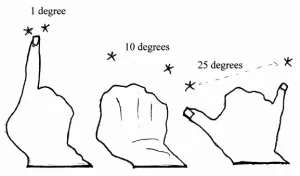
'Twentyfive'. Horns?
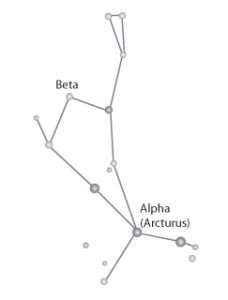
Bootes. Kite shape?
In the Egyptian Astronomical Texts, Neugebauer and Parker (1960, 150) inform us that the deities of the decans are the ‘children of Horus’....Star sightings and bird spotting had shared synergy. Particularly noteworthy by different observers were the red-kite ‘first’ sightings. The Egyptians, who identified these raptors with Isis and Nephthys, goddesses of the cardinal points West and East, reported the bird’s return in the Ptolemy document on days 12 and 13 of the month of Phamenoth– dates which convert today to 13 and fourteen March. Also recorded on these two days was the appearance of Arcturus and its evening rise, a phenomenon which modern astronomers (Falconer, personal communication, December 2006) refer to as the star’s ‘Last Acronychal Rising’. Several centuries prior to Ptolemy, we know from Hesiod { Erga, 564–567) that on mainland Greece, the Last Acronychal Rising sighting of Arcturus is estimated to have been 'twentyfour' February, and was fixed as the date to start pruning the grape vines.
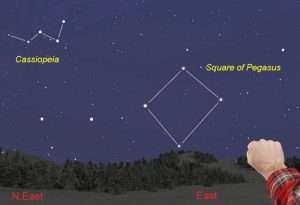 The Bald ibis depiction on the recovered sherd looks like a free-hand drawing that pays scant attention to the later established conformist, square Canon of Proportion. However, it does seem to have its own hidden geometric base criteria – some sort of a hitherto unremarked ‘Canon of Circle’. The dorsal body of the bird is an arc....The Bald Ibis, identified by the Egyptians as the metamorphosis of the ethereal ‘spirit’, was represented by the sound value ‘akh’....'' [Academia: 'The First Decan' {2008}: Roz Park].
The Bald ibis depiction on the recovered sherd looks like a free-hand drawing that pays scant attention to the later established conformist, square Canon of Proportion. However, it does seem to have its own hidden geometric base criteria – some sort of a hitherto unremarked ‘Canon of Circle’. The dorsal body of the bird is an arc....The Bald Ibis, identified by the Egyptians as the metamorphosis of the ethereal ‘spirit’, was represented by the sound value ‘akh’....'' [Academia: 'The First Decan' {2008}: Roz Park].
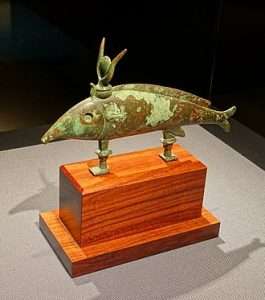
Fisher of Man? Natural or symbolic?
And/or: "If truth were the same for everyone, then things would indeed be simple. But it is not. Truth is a concept, and so varies with the individual as situations and backgrounds vary....Do not confuse truth with Law. A group of men may make a law, and by so deciding it becomes truth within his tribe - but man-made truth only. Another group may recognise a law of nature which is universal to all creation - and this is truth - but truth not made by man. And then of course there are those grey area's of spiritual morality which are neither black nor white, but remind us that there no absolutes in creation. Truth which is derived from the patterns of nature, is the closest we can come to Absolute Truth. This is why the Druids founded 'colleges', where all learning and philosophy is patterned after natural phenomenon: the cycles of seasons, the science of rainbows and light {'Golden arrow'?}, the ways of beasts {'cattle'?} or stars...'Natural philosophy' we call it. These teachings are not from the 'hand' of men - but from the Hand of 'He' who dwells in The Beyond {that ''bit''?}. And so certain learnings and truths are clearly identified beyond others..." [Page 218 same book].
From a different perspective: ''Gandalf is a protagonist in J. R. R. Tolkien's novels The Hobbit and The Lord of the Rings. He is a wizard, one of the Istari order, and the leader of the Fellowship of the Ring. Tolkien took the name "Gandalf" from the Old Norse "Catalogue of Dwarves" (Dvergatal) in the Völuspá. As a wizard and the bearer of one of the Three Rings, Gandalf has great power, but works mostly by encouraging and persuading. He sets out as Gandalf the Grey.''
Think about it all - especially the words in brackets {as one example} relative to that ''framework''.
'Shades of Grey'?
Archetypes? As a means to understand something internal? ONCE a 'connection' is made? {H/V?}.
''Sunshades''?
'Greyjoys'? {Game of Thrones}.
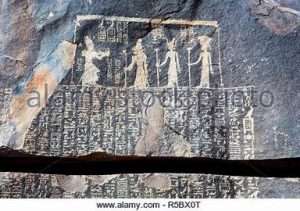
An ''idea'' wrapped up in hieroglyphs?
A {working?} example: "In general, many of the things G. had said astonished me....Other things, on the contrary, coincided strangely with what i had thought myself and with what i had arrived at long ago. I was most of all interested in the connectedness of everything he said. I already felt, that his ideas were not detached from one another...but made one whole, of which as yet, i saw only some of the pieces. I thought about that on the night train from Moscow to Petersburg. I asked myself whether i had indeed found what i was looking for. Was it possible that G. actually knew what had to be known in order to proceed from words or ideas to deeds, to ''facts''? I was still not certain of anything, nor could i formulate anything precisely. But i had an inner conviction that something had already changed for me and that now everything would go differently." ['In Search of the Miraculous'].
Try ''idea'' and or ''Kerenyi' to take it further.'
Analogy {in a different sense of the word?}: "What is decisive for me is that i dream about physics as Mr. Jung [and other non-physicists] think about physics. Every time i have talked to Mr. Jung [about the ''synchronistic'' phenomenon and such], a certain spiritual fertilization takes place." Wolfgang Pauli.
"Perhaps in this way we shall attain the high philosophical goal of perceiving how the divine life in man is joined in all innocence with animal life." [Quote by Goethe. Taken from the inset pages, i.e.,first quote; first paragraph of the book by C. Kerenyi]. ''Fall'' and ''child'' link?
 A {working?} example: "Knowledge is one thing, understanding is another thing. People often confuse these concepts and do not clearly grasp what the difference is between them. Knowledge by itself does not give understanding. Nor is understanding increased by an increase of knowledge alone. Understanding depends upon the relation of knowledge to being. Understanding is the resultant of knowledge and being. And knowledge and being must not diverge to far, otherwise understanding will prove to be far removed from either {'Afar'?}. At the same time the relation of knowledge to being does not change with a mere growth of knowledge. It changes only when being grows simultaneously with knowledge. In other words, understanding grows only with the growth of being." ['In Search of the Miraculous']. Try ''simultaneously''.
A {working?} example: "Knowledge is one thing, understanding is another thing. People often confuse these concepts and do not clearly grasp what the difference is between them. Knowledge by itself does not give understanding. Nor is understanding increased by an increase of knowledge alone. Understanding depends upon the relation of knowledge to being. Understanding is the resultant of knowledge and being. And knowledge and being must not diverge to far, otherwise understanding will prove to be far removed from either {'Afar'?}. At the same time the relation of knowledge to being does not change with a mere growth of knowledge. It changes only when being grows simultaneously with knowledge. In other words, understanding grows only with the growth of being." ['In Search of the Miraculous']. Try ''simultaneously''.
''Line of Sight''?

'M' or 'W'? Synchronistic?
REFRESHER: "The science of the I Ching, indeed, is not based on the causality principle, but on a principle {hitherto unnamed because not yet met with among us}, which I have tentatively called the 'synchronistic' principle. My occupation with the psychology of the unconscious processes long ago necessitated my casting around for another explanatory principle, because the causality principle seemed to me inadequate for the explanation of certain remarkable phenomena of the unconscious {Wolfgang Pauli?}. Thus I found, that there are psychic parallelisms which cannot be related to each other causally, but which must stand in another sort of CONNECTEDNESS. This connection seemed to me to lie mainly in the relative simultaneity of the events, therefore the expression 'synchronistic'..." [Page 141, The Secret of the Golden Flower / R. Wilhelm WITH a commentary by G. Jung].
Try ''simultaneous'' to see subject material in the universal sense of the 'word' - since the oral tradition BEFORE ''the written word came into common use''.
Analogy: ''Seeing comes before words. The child looks and recognizes before it can speak. But there is also another sense in which seeing comes before words, but word can never undo the fact that we are surrounded by it. The relation between what we see and what we know is never settled." ['Ways of Seeing' / J. Berger].
''...and what we know is never settled."
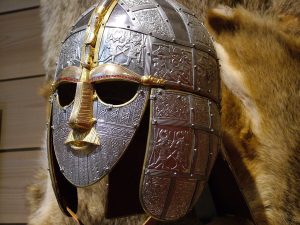
Artistic creation? Myth?
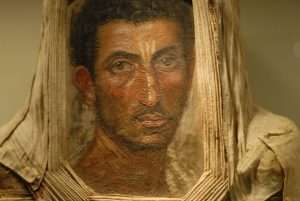
Face to face? With what?
And yet the same author defines mythology as: "The highest category in oil painting was the history or mythological picture. A painting of Greek or ancient figures was automatically more highly esteemed than a still life, a portrait or landscape. Except for certain exceptional works in which the painters own personal lyricism was expressed, these mythological paintings strike us today as the most vacuous of all. They are like tired tableaux in wax that won't melt. Yet their prestige and their emptiness were directly connected...They did not need to stimulate their imagination. If they had, they would have served their purpose less well. Their purpose was not to transport their spectator-owners into new experience but to embellish such experience as they already possessed.

'Stamp of the feminine'. Real or symbolic?
Before these canvasses the spectator-owner hoped to see the classic face of his own passion or grief or generosity...Sometimes the borrowing of the classic guise was simple, as in Reynold's painting of the daughters of the family dressed up as Graces decorating Hymen. Sometimes the whole mythological scene functions like a garment held out for the spectator-owner to put his arms into and wear. The fact that the scene is substantial, and yet, behind its substantiality, empty, facilitates the 'wearing' of it... "
Subjective OVER objective? Question. When ALL the available information is accessed - and not just the 'artistic' one - what do you think? Try ''garment''.
REFRESHER..."Perhaps in this way we shall attain the high philosophical goal of perceiving how the divine life in man is joined in all innocence with animal life." [Quote by Goethe. Taken from the inset pages, i.e.,first quote; first paragraph of the book by C. Kerenyi]. ''Fall'' and ''child'' link?
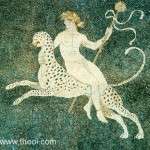
Male or female cat?
#
Analogy of same?..."Radin's trickster cycle preserves the shadow in its pristine mythological form, and thus points back to a much earlier stage of consciousness which existed before the birth of the myth, when the Indian was still groping about in a similar mental darkness.
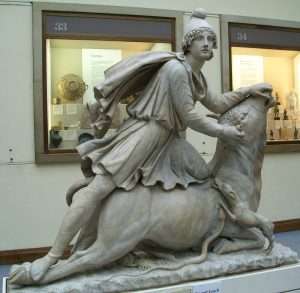
In profile or face on?
Only when his consciousness reached a higher level could he detach the earlier state from himself and objectify it, that is, say anything about it. So long as his consciousness was itself 'trickster like', such a confrontation could obviously not take place. It was possible only when the attainment of a newer and higher level of consciousness enabled him to look back on a lower and inferior state..." [From the chapter entitled 'On the Psychology of the Trickster Character' by C. Jung - within the book 'The Trickster' by P. Radin].
Link to 'hindsight' and therefore 'foresight'? {by way of the objective process?} Benefits of - purpose of - if only in defining a subject?
Cro-Magnon man in relation to Neanderthal man? Enlarged elsewhere.
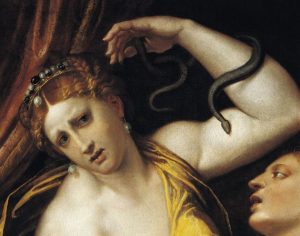
What's the remedy for 'snake bite'? How could she be resurrected? Where would that be REPRESENTED within {say} a landscape?
Understanding 'subject material' defines the following - BEFORE those two bigger questions are asked: "Reason; imagination - the words he thought he was speaking in hushed tones bounded back from the echoing vaults {Plato's shadows? as a means...?} . He became dizzy. He waited for Maitre Jacques's answer as for something to lean on. Maitre seemed to whisper in his ear: 'It is Mind that ought to be controlled by That which knows the Causes, because left to itself, it cannot judge without comparing, without dealing in 'duality'. The Mind is the 'serpent' of the Genesis, the Dualist that separates Adam-Eve, so that they can look at themselves'..." ['Journey Into the Light' / Isha Schwaller de Lubicz]. See it? Try Part 1?
Then try redeemed/unredeemed. And/or poison/antidote. All as a means...?
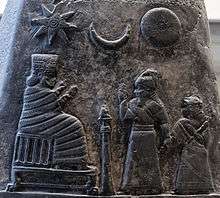
'Spots' or 'stripes'?
Side note: {something extra? OR a 'direction' for further investigation}: "With this experience comes a new understanding of what is meant by ''Mother Nature'', or the feminine aspect of the 'Life Power' {that ''bit''?}. That is why all three cards of the Tarot that relate to the third stage of unfoldment so emphasize the feminine. In the 3rd and 17th keys the central figure is a woman - the same woman, in fact. In the 10th key the title of the card points to the working of the same feminine power, for this is the Wheel of Fortune, the goddess whom the Greeks call Panthea - or she in whom all the feminine aspects of 'deity' were synthesized." [Page 163 'Occult Fundamentals and Spiritual Unfoldment' / P. F. Case. Vol 1].
Try ''lucky/unlucky''.
Recall the ''feminine'' aspects of Nefertiti / Hatshepsut / Cleopatra.
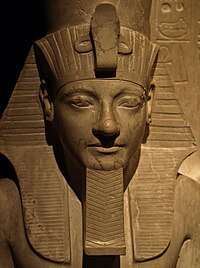
Wearing what?

'flat'?
"Panthera is a genus within the family Felidae that was named and described by Lorenz Oken in 1816 who placed all the spotted cats in this group.[2][3] Reginald Innes Pocock revised the classification of this genus in 1916 as comprising the tiger (P. tigris), lion (P. leo), jaguar (P. onca), and leopard (P. pardus) on the basis of common cranial features.[4] Results of genetic analysis indicate that the snow leopard (formerly Uncia uncia) also belongs to the genus Panthera (P. uncia), a classification that was accepted by IUCN Red List assessors in 2008....In Panthera species, the dorsal profile of the skull is flattish or evenly convex."
'Indian Givers: How Native Americans Transformed The World' / J. Weatherford.
Nubians?
Question. Why should they {regardless of whether a myth or not} be associated with the Arc of the Covenant?
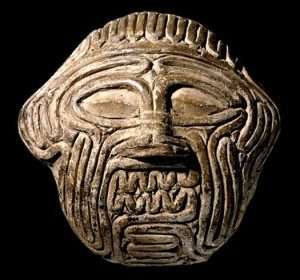
A labyrinth of wrinkles? Old age?
From a different perspective: "The statements {within the Aztec codex} focus attention on the belief that the world has already passed through 'four' epochs or 'Suns'. The First and most remote of these is represented by Ocelotonatiuh, the jaguar god: 'During that 'sun' lived the 'giants' that had been created by the gods but were finally attacked and 'devoured' by jaguars {'lower Self's'?}....The symbol of the Fifth Sun, our current epoch, is the face of Tonatiuh, the sun god himself. His tongue, fittingly depicted as an obsidian knife, juts out hungrily, signifying his need for 'nourishment' of human blood and hearts. His features are wrinkled to indicate his advanced age and he appears within the symbol Ollin which signifies Movement. Why is the Fifth Sun known as ''The Sun of Movement''? Because the elders say: in it there will be a 'movement' of the earth and from this we shall all perish." [Page 99 'Fingerprints of the Gods' / G. Hancock].
Jaguar = Panther. Jaguar in 'control'?
Try ''Static/Dynamic''. ALL as a means....?

'How the Leopard gots its spots'.
Recall the Leopard or Lion skin {'spotted'?} on the SHIELD that was found among the 'items' within the tomb of Tut. [Program narrated by Dan Snow].
'Dionysos: Archetypal Image of Indestructible Life' by C. Kerenyi. and/or 'Undoing Yourself' by Christopher S. Hyatt. And / or 'Schizophrenics Can Be Good Mothers Too' by Q. S. Lam. A book that redefines this subjects main ''teaching aid.'' In basic terms. In its most practical. Enlarged elsewhere.
'Cognitive Behavioral Therapy: Techniques for Retraining The Brain' / J. Satterfield.
Shadow in relation to light. Representation of, i.e.,Dionysus associated more with Artemis. 'Moon' in relation to 'sun' [symbolism of]. A reflection upon something, relative to an understanding. From something unaware to aware. That 'unknown' something, that once 'known' is represented by the light of the sun, [Apollo?]. The beginning of which would be represented with the word ''dawn.''
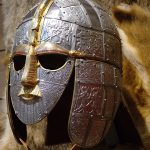
What do dragons REPRESENT?
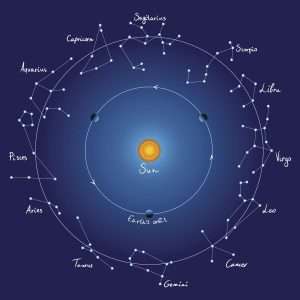 From a different {broader horizon mindset?} perspective: "As we study the moons nodes, we are considering a relationship established between the plane of the Moon's orbit and that of the Earth's orbit. The later is centered around the Sun, like all planetary orbits. But the former is centered around the Earth. Thus the relation Moon-orbit to Earth orbit translated in terms of the relation between these two orbits centers becomes the relation Earth to Sun! But this is a new type of Earth to Sun - one which refers to the innermost meaning of the possibility of adjustments between , on one hand, the Earth centered ego and his will; on the other, the Solar Self and His Will. What is seen therefore through the Moon's nodes is the relation between the ''human'' will and the ''divine'' will....At the Moon's North node we see Destiny at work; at the South node human will....More than anything else, it tells the ''Why'' of individual life. Why the particular ego {'dragon'?} was projected out of the ocean of universal life - why we are born and what for....The way in which an individual will orientate himself along this line of destiny will largely determine whether his life will be a success or a failure, or, more correctly, whether his accomplishments can be tabulated as positive or negative ones.....{in relation} to mental crystallizations....The axis constituted by the Moon nodes deals most directly with the very process of individuation. Here we see at work the forces which try to integrate the particular ''I'' and the greater Self; the faculty of assimilating new substance of living and of rejecting the values which are no longer useful....If we should lie along the nodal axis we would look into the 'future' facing North, and accept the 'past' facing South. The North node deals, therefore, with the work to be done, the new accomplishment, the new 'faculty' to be developed; if we are willing to exert ourselves in that 'direction'....The south node represents the work that has been done, the well known accomplishment, the routine performance already gone through....
From a different {broader horizon mindset?} perspective: "As we study the moons nodes, we are considering a relationship established between the plane of the Moon's orbit and that of the Earth's orbit. The later is centered around the Sun, like all planetary orbits. But the former is centered around the Earth. Thus the relation Moon-orbit to Earth orbit translated in terms of the relation between these two orbits centers becomes the relation Earth to Sun! But this is a new type of Earth to Sun - one which refers to the innermost meaning of the possibility of adjustments between , on one hand, the Earth centered ego and his will; on the other, the Solar Self and His Will. What is seen therefore through the Moon's nodes is the relation between the ''human'' will and the ''divine'' will....At the Moon's North node we see Destiny at work; at the South node human will....More than anything else, it tells the ''Why'' of individual life. Why the particular ego {'dragon'?} was projected out of the ocean of universal life - why we are born and what for....The way in which an individual will orientate himself along this line of destiny will largely determine whether his life will be a success or a failure, or, more correctly, whether his accomplishments can be tabulated as positive or negative ones.....{in relation} to mental crystallizations....The axis constituted by the Moon nodes deals most directly with the very process of individuation. Here we see at work the forces which try to integrate the particular ''I'' and the greater Self; the faculty of assimilating new substance of living and of rejecting the values which are no longer useful....If we should lie along the nodal axis we would look into the 'future' facing North, and accept the 'past' facing South. The North node deals, therefore, with the work to be done, the new accomplishment, the new 'faculty' to be developed; if we are willing to exert ourselves in that 'direction'....The south node represents the work that has been done, the well known accomplishment, the routine performance already gone through....
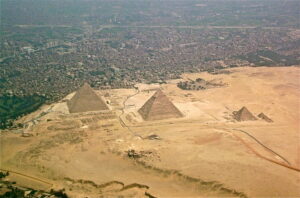
'Past' or 'future'?
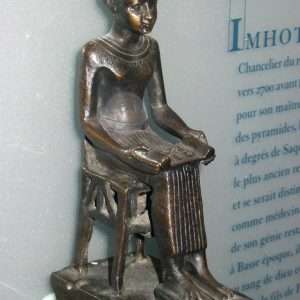
Becoming or 'undoing'?
The past will have to die before the future may live. And we shall find ourselves deprived of our inborn gift by some stroke of 'destiny', because we had become identified with it, lost in it, ''undone'' by it. This is truly our ''self undoing''. [Pages 256-259 'The Astrology of Personality' / D. Rudhyar].
And/or: Various Mystery Schools from Ancient Egypt onwards have maintained the tradition. The principle work of the Western Esoteric Tradition is expansion of consciousness. It deals with the ‘ground of all being’, unmanifest, beyond time and space, which differentiates countless nodes of being evolving through a manifest universe. The purpose of these nodes of being is to realise the Divine Intention, which as a play is an image in the mind of the playwright until the actors make it real in performance. It is for us to recognise and handle constructively what flows from this proposition. The Divine Intention is concerned with the true purpose and destiny of each one of us. ['The Society of Inner Light'].
Define those keys to get into a mindset. To ''see'' what those in the past and those in the future attempt to 'see'.
''Undoing''?

Sanity or insanity? Bitter or sweet?
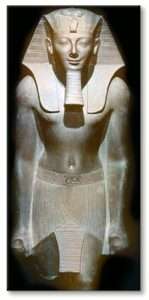
"Savouring the sweet while remembering the bitter." {Bruce Lee}.
Something hinted at: "I welcome you as i would welcome a poor man who would die of hunger if he didn't get food. Its not for me to judge the cause of his undoing. I give him what i have, because he is a man like me. Neither would i judge him if he responds like a beggar did one day, by throwing away the soup that had been offered to him, because it would have spoiled his absinthe. The bitterness of your absinthe has inebriated you with a kind of madness from which you are afraid of awakening..." ['Journey into the Light'].
Reek? [Game of Thrones}.
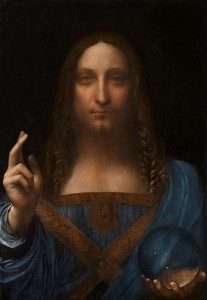
Multiplication?
Wormwood is mentioned seven times in the Hebrew bible, always with the implication of 'bitterness'. Translated from the Hebrew word that means ''curse''. Wormwood is mentioned only once in the New Testament, in the Book of Revelation: "The third angel blew his trumpet, and a great star fell from heaven, blazing like a torch, and it fell on a third of the rivers and on the springs of water. The name of the star is Wormwood. A third of the waters became wormwood, and many died from the water, because it was made bitter." (Rev 8:10–11).
'Eight'.
Side note: Those numbers again 'seven' and 'three'. Add them and multiply them. What do those numbers represent within the whole?
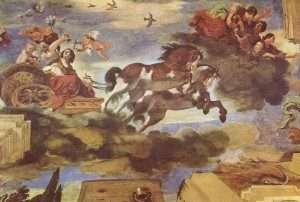
The Roman Goddess of Dawn. Whose brother was the sun, and sister the moon. Painted by the same artist, as that of The Shepherds of Arcadia. Boehmes first book after twelve years was called Aurora, supposedly never finished. As are a number of publications. Purposely. Question. Why? All dried up?[ Eclipse Of The Sun: An Investigation Into Sun and Moon Myths by J. McCrickard].
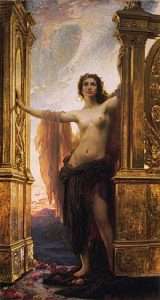
Goddess of Dawn. Gateway to the light. Refresher: "Dawn always begins in the BONES."
And/or: The folk ballads nearly all insist on wrestling, though the death is by stabbing. Possibly two practices have been condensed into one, the ritual maiming and stabbing to death would normally have been quite distinct events, separated by at least a year if not a longer period of time. One could consider the reference to the brothers fighting beneath a ‘wrestling’ or ‘struggling’ moon to imply that there was a definite right time for this activity. It should be noted that folk ballads seldom colour their plots with metaphor, and where this process occurs it is usually of a very specific nature, and not a poetical conceit. We do know that early people carefully calculated and observed the celestial patterns. The ritual Sacrifice was supposed to have been made when Sun and Moon were equal in the sky, approximately every eight years.....Seven are the Seven Stars in the Sky, the Shining Stars be Seven Oh Eight it is the Morning’s break when all the World’s awake Oh Nine it is the pale Moonshine, the Shining Moon is Nine Oh....EIGHT. The Great Archangel, The Eight Archangels, The April Rainers, and Eight it is the Mornings’ break when all the world’s awake Oh.
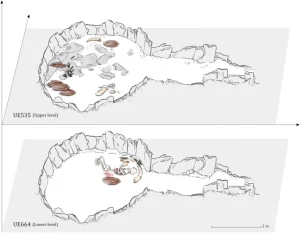
Even though Copper Age funerary practices in Iberia are largely characterized by collective inhumations, burial 10.049 at Valencina yielded the remains of a single individual interred as a primary inhumation (Fig. 2). This burial is remarkable for several reasons33,34. The individual buried in it was first identified as a probable young male between 17 and 25 years of age at the time of death based on standard anthropological analysis35. Strontium isotopes showed this individual to be of local origin, while at the same time, strikingly high levels of mercury in the bones revealed intense ante-mortem exposure to cinnabar36. This person was accompanied by a lavish set of prestige goods that included a large ceramic plate (in which chemical traces of wine and cannabis were found—Personal communication by Nicolas Garnier and Elisabeth Dodinet), a small copper awl and multiple flint and ivory objects (Fig. 2: lower level and Fig. 3). Remarkably, amongst the latter was a full tusk, weighing 1.8 kg, of an African elephant, which is unparalleled in western Europe37,38. Sometime after this burial, another offering was made to the individual buried in tomb 10.049 (Fig. 2: upper level and Fig. 4): a set of flat slate slabs were carefully laid above, and further grave goods were then deployed, including several large ceramic plates and many more ivory objects. Among the latter, a beautiful dagger with a blade made of rock crystal and an ivory handle decorated with 90 perforated discoid beads made of mother of pearl stands out37,39.
This last beautiful line of poetry gives us yet another surprising link out of apparent fancy which only makes sense within the cosmic interpretation of the song. The Eight Sphere, that of Glory, is linked to the Archangel Raphael. He is the Keeper of the Gates of Dawn, and his angels—the Bene Elohim—are the ‘inspirers’ who create new horizons within the intellect of mankind....‘Eight it was a landscape’ is not open to mystical interpretation, but is good poetry within the song. {'Where is Saint George' / Bob Stewart}.
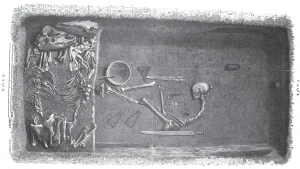
The tomb at the center of the debate is known as Bj 581, after its location when it was excavated at the Birka settlement on the island of Bjorko, which is west of Stockholm, with easy access to the Baltic Sea. (Unesco designated the settlement a World Heritage Site in 1993.)
Continued: The Greek word Apsinthos, which is rendered with the English "wormwood", is believed to refer to a plant of the genus Artemisia, used metaphorically to mean something with a bitter taste. The English rendering "wormwood" refers to the dark green oil produced by the plant, which was used to kill intestinal worms. In the Book of Revelation, it refers to the water being turned into wormwood, i.e. made bitter.
The Swedenborgian New Church follows a spiritual interpretation of the star Wormwood based on other passages of scripture which mention gall and wormwood. The star signifies self-derived intelligence which departs from God, thus it falls from heaven. For the star to make the waters of rivers and fountains bitter signifies to falsify spiritual truths, as waters signify truths derived from the Word. In general, the Book of Revelation is seen as a prophecy of the corruption of the Christian churches in the end times which is followed by a New Church, signified by the New Jerusalem.

Ethiopian flag. Within the 'Horn' of Africa. Supernova?
A number of Bible scholars consider the term Wormwood to be a purely symbolic representation of the 'bitterness' that will fill the earth during troubled times, noting that the plant for which Wormwood is named, Artemisia absinthium, or Mugwort, Artemisia vulgaris, is a known Biblical metaphor for things that are unpalatably bitter. [Wiki].
'Star' = supernova = Antares? {i.e., prediction based on the ''bitterness'' of the Scorpion. 17/10/20}.
Try ''Worm'' / ''Bitterness/Sweetness' to enlarge into that mindset. Then try ''Supernova''.
And/or: "The phrase ''through the seven Worlds of Maya'' refers here to the seven globes of the planetary chain and the seven rounds, or the fortynine stations of active existence that are before the ''Spark'' or Monad, at the beginning of every ''Great Life Cycle'' or Manvantara. The ''thread of Fohat'' is the thread of life before referred to. This relates to the greatest problem of philosophy - the physical and substantial nature of life, the independent nature of which is denied by modern science because that science is unable to comprehend it." [Page 238 ' The Secret Doctrine' / H. P Blavatsky].
Static/Dynamic?
7x7?
Sed Jubilee or ''half a cycle'' of something?

English, German or Double-Dutch? Professional or an obsessive? Money back?

Anima or animus?
A modern {present?} definition of same? "Within the personality, embedded in the unconscious, are complexes living a life of there own like separate ego's. Normal man depends on his complexes for much of his inspiration. The complexes have a positive role, but also a negative one, for they give rise to inner feelings of uncertainty, they can have a disintegrating effect on consciousness. Analysis of the personal unconscious reveals much of this unconscious material. Archetypes are not so readily brought into consciousness. They are often vague and borderline. We might find a ''nay'' countering our conscious ''yea'' and we are led to ask who this other fellow is. By listening as if it were an ego speaking we can hear what he has to say. In this way we can contact such figures as the animus and anima. The animus is the unconscious masculinity in the feminine psyche, while the anima represents the unconscious feminine in the male psyche. The personifying of such archetypes makes it possible to have a discussion with them without the ego having been swamped by them in a way in which they are indistinguishable from ones own thoughts or moods. To personify such figures means to acknowledge their entity.
A working example: ''What we did is name my tics. Its like an alter-ego thing - so we callled it Frankie...its like somebody else.'' Betsy: 'Britains Tourette's Mystery' / Ch. 4 / 2022].
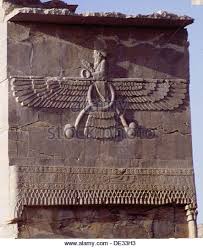
An objective eye? If only from right to left?

Winged 'dragon' or 'serpent'?
For instance, a man might be suffering from a mood. He feels the mood as himself. He might be so blinded by the mood that he does not see it as unreasonable, or he might even have a vague knowledge that the mood does not have to do with his masculine ego. He might even be conscious enough to say or think: "I know the mood is unreasonable, but i can't stop being like this." If he personifies that mood, say as the anima; for she frequently acts moodily; he has a chance to disentangle himself from the mood and look at it objectively. To be identical with the mood means to be in a primitive state of possession wherein the ego is submerged by primitive emotion and not in a position to reason. To reason is an attribute of mans conscious logos, so by separating from the unconscious by means of personification, one is no longer identified of critical judgement. A situation is created wherein one can stand back and look at things squarely." ['The Old Wise Woman: A Study in Active Imagination' / Rix Weaver]. Anything?
''Squarely'' {objective?} in relation to 'right angle' ? And/or ''Conjunction''? As a means...?
Question. Hindsight/foresight? Try ''Neanderthal'' for something further {deeper?}.
Side note: ''The Latins occasionally wrote the word Scorpios, but usually Scorpius, or Scorpio; while Cicero, Ennius, Manilius, and perhaps Columella gave the kindred African title Nepa, or Nepas, the first of which the Alfonsine Tables copy, as did Manilius the Greek adjective, 'Walking Backward'. Astronomical writers and commentators, down to comparatively modern times, occasionally mentioned its two divisions under the combined title Scorpius cum Chelis; while some representations even showed the Scales in the creature's Claws.''
Question. What two aspects is the ''scorpion'' known for?
''Life can only be understood backwards, but must always be lived forwards." Enlarged elsewhere.

Redeemed/unredeemed?
REFRESHER: "Mary Magdalene: One of the female disciples of Jesus who 'discovered' his resurrection and declared it to the disciples hiding in the 'Upper' room. The loyalty and special place of Mary M. is of so an impressive a character that it has been passed into folklore - often to the extent of making her Christ's physical consort." [Page 178 'The Western Way'. Vol 2].
Try ''M''.
"Scorpio has not always been a scorpion. In Egypt it was a viper or cobra, according to most sources. Our own symbol for Scorpio {'m'}….is taken for the snake hieroglyph." [Page 56 'Arachne Rising'].
And/or: ''The Latin word for 'alive' is Viper.'' ['The Chase'].
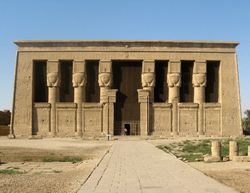
Denderah in Egypt.'Three' either side of ''gateway''. Higher or lower? 90 or 180?
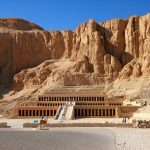
'Twelve' either side. Try ''25'' for something extra.
And/or: ''They said that Osiris was slain, by which they meant: the old life in the imaginations vanished when the setting sun in autumn stood at 17 degrees of Scorpio and, in the opposite point in the heavens {Orion?}, the full moon rose in Taurus, or in the Pleiades. The Followers of Osiris declared this definitive point of the year marked by the full moon rising in Taurus, as the time when Osiris vanished from the earth, that is, when he was no longer present there....This rememberence was to be preserved, and all sorts of secrets surrounded it. The time in which Typhon had slain Osiris in November when the sun sets in the 17th degree of Scorpio, and opposed to it in Taurus the full moon appears in the Pleiades. It is further related that Osiris once more betook himself from the Underworld, where he rules over the dead and judges them, to the Upperworld in order to instruct his son Horus, whom he engendered by Isis. Then Isis let herself {'higher'?} be induced {by way way of 'Horus'} - to free Typhon {'lower?}, whom she had held imprisoned. Horus, instructed by Osiris, grew so angry at this {therefore still in the 'lower' phase?} that he 'quarreled' with Isis his mother and seized the crown from her....he then set cow horns upon her {'his'?} head.....'' [Page 61 'Ancient Myths' / R. Steiner. All emphasis, this readers].
Try ''seventeen''.
 Continued: "On the plane, twice two makes four, and twice four makes the cube of two, all this by addition and movement of the plane. But it takes twentyseven cubes for the original 'cube' to grow, doubling itself in all directions in space. One may add cubes to cubes, but one must be able to be 'cube with the cube' in order to 'know' it. This is the faculty of synthesis. We are advised as a disciple of thought to objectify every idea. The sage, to the contrary, seeks to put an end to duality {'intuition'?}. One learns to know the object, but one knows 'life' through inborn knowledge." ['Esoterism and Symbol' / R. A. Schwaller de Lubicz. Emphasis, this readers]. Try ''27'' {twentyseven}.
Continued: "On the plane, twice two makes four, and twice four makes the cube of two, all this by addition and movement of the plane. But it takes twentyseven cubes for the original 'cube' to grow, doubling itself in all directions in space. One may add cubes to cubes, but one must be able to be 'cube with the cube' in order to 'know' it. This is the faculty of synthesis. We are advised as a disciple of thought to objectify every idea. The sage, to the contrary, seeks to put an end to duality {'intuition'?}. One learns to know the object, but one knows 'life' through inborn knowledge." ['Esoterism and Symbol' / R. A. Schwaller de Lubicz. Emphasis, this readers]. Try ''27'' {twentyseven}.
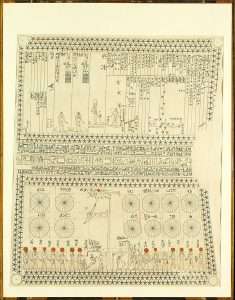
Astro ceiling in Senenmut bare tomb chamber. 'Folded'?
From a different perspective: "Scholar Arthur Waley has discovered magic thread reference in I -Ching, oracle 29:

Knot in the belly.
'Bind with a thread of three strands and two strands, put it in a bramble thicket {'Hawthorn'?} - and you will get your wish after three years'. This 27 line oracle is usually called 'The Pit' or The Abysmal'. But its Chinese name usually means the double or folded pit {'cube'?}. Waley believes it is connected with lunar ritual, being 'one hole opening out of another'...'' [Page 79 'The White Goddess' ].
'Turquoise'?
'On Having No Head: Zen and the Rediscovery of the Obvious' / D. E. Harding.
As {seen?} from a different perspective? "The writer is 'double'. There is the Self that does the writing, and there is the Self that does the living. And they talk and they argue. Writing is talking to oneself - and I've been doing it all my life - long before i first saw this house 5 years ago." [Alan Bennett 'Lady in a Van']. Enlarged elsewhere.
A BALANCE of the 'two' ? WHAT represents it?
Side note: {and/or answer?}: ''For my hermetic egg. i have decided, after long deliberation, upon a double pelican.'' [Page 11 under the chapter 'Calcination' from the book 'Mercurius' / P. Harpur].
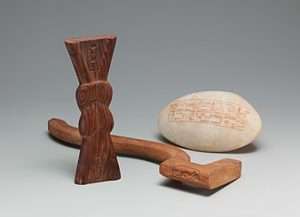
Someones new name.
Side note: Analogy: ''This land i hold is the place where the Pelican Dreaming meets the Brown Snake Dreaming. It is the most sacred land, for it holds another world within it. It holds the Dreaming {'images/hieroglyphs' etc}. It holds the ancestors. It holds the future......The open PLAIN landscape is where the Dreamtime lives {'archetypes'}... It includes a mythological distant past when the CREATIVE spirits moved over the land, shaping it, NAMING it, calling it into BEING....Those creative SPIRITS known as Pelican and King Brown Snake are said to have met {'crossroads'?}..... so that it seems that the mythic time beyond time is overwhelming our little local time.'' [Page 12/13 'A Mythic Life' / J. Houston].
A working example: ''Baby Pelicans piercing into their own Mothers breast/Heart...a sign that points to a deeper reality {in relation to the Upper Room of the Last Supper and/or the Washing of Feet i.e., lower room}. ['Pilgrimage of Grace' / Magdala /March 2022].
Continued: And/or {simplified?}: "Everyone has an internal thought process: that silent other self who speaks to you; the one you debate with." [First sentence; first paragraph; first page of the book by Q. S. Lam].
A working {initiate?} example: Maitre Jacques {'higher'/pos} Versus Pierre du Coignet {'lower'/neg} - both in relation to the main character of the book John {Jean} Thomas. Enlarged elsewhere. Question. Archetypes only?
'Dreamland' / Pet Shop Boys.
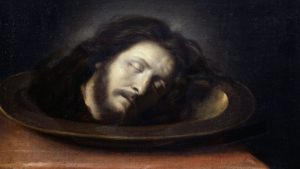 "How dare you speak to me in that way, you are neither Light nor divine power?''... 'No, but i am the means, the precursor of light.' ...''Oh, is that so? Well, then go ahead. I defy you to prove your power.'' ... As they spoke Pierre and Jacques, who had been 'walking' through the large nave, had arrived in front of the holy water basin. Dumbfounded, Jean Thomas watched Maitre Jacques punch Maitre Pierre and precipitate him into the holy water basin, which was transformed into an enormous shell {Venus link?}. A great shout was heard. The water started to crackle, and Jean Thomas found himself alone with Maitre Jacques. He hardly dared to speak. He drew near to touch the mysterious water with his own fingers, and while he contemplated it, he thought he saw the body of Pierre melt into that of Jacques, like salt dissolving in water..." ['Journey Into the Light'. Includes italics ]. Try ''shell' and/or ''salt'' for further 'connections' {eureka moments?}.
"How dare you speak to me in that way, you are neither Light nor divine power?''... 'No, but i am the means, the precursor of light.' ...''Oh, is that so? Well, then go ahead. I defy you to prove your power.'' ... As they spoke Pierre and Jacques, who had been 'walking' through the large nave, had arrived in front of the holy water basin. Dumbfounded, Jean Thomas watched Maitre Jacques punch Maitre Pierre and precipitate him into the holy water basin, which was transformed into an enormous shell {Venus link?}. A great shout was heard. The water started to crackle, and Jean Thomas found himself alone with Maitre Jacques. He hardly dared to speak. He drew near to touch the mysterious water with his own fingers, and while he contemplated it, he thought he saw the body of Pierre melt into that of Jacques, like salt dissolving in water..." ['Journey Into the Light'. Includes italics ]. Try ''shell' and/or ''salt'' for further 'connections' {eureka moments?}.
Question. Baptism of fire and/or dark night of the soul?

Crystal or 'rock' ?
A {practical?} example: "I recollect that the talks which followed that evening struck me by the fact that many people heard something entirely different to what G. had said; others only paid attention to G.'s secondary and nonessential remarks and remembered only these. The fundamental principles in what G. said, escaped most of them. Only very few asked questions on the very essential things he said. One of these questions has remained in my memory: 'In what way can one evoke the struggle between ''yes'' and ''no'' in oneself?', someone asked. 'Sacrifice is necessary, said G. If nothing is sacrificed nothing is obtained...Sacrifice is necessary if only while the process of crystallization is going on'..." ['In Search of the Miraculous' / P. D. Ouspensky]. Try ''yes/no'' and/or ''crystalliz{s}ation'' and/or ''sacrifice''.
And/or: Saturn, as you know, is the binding, crystallizing vibration. The pair of opposites assigned to it is Dominion and Slavery, because our expression of this 'vibration' {i.e., in the ''energy'' sense of the word, i.e., recall J. Campbell's quote}, either frees or limits us, according to the point of view that we take. " [Page 51 of the book by P. F. Case. Vol 1].
"To sacrifice a 'lower' value to a 'higher' value is to give substance and power to the desire which has been 'sacrificed'. If this higher value is of a 'spiritual' order, the spiritual power is attracted by this desire, and givers to the sacrificer a power of domination over his lower states." ['Journey into the Light'].
Question. Breaking {changing?} old habits into newer ones? Benefit of?
Imhotep ? As a means....?
Exercise: To which of the 'three' individuals has 'Venus' been ''attracted' too?

Breast feeding?
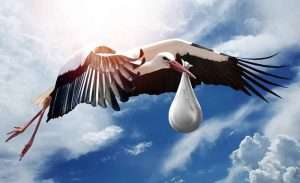 A {working?} present example: "This book makes no pretence whatever of being 'learned'. The author has brooded over these things for many years, painfully aware of the overshadowing mass of research and scholarship, compared with which her efforts are no more than little glow worm lamps in the night. It is an attempt to reawaken in certain legends and myths, chiefly of Celtic origin, their slumbering secrets...Such a book, too, can have no ''style''. It must all the time be struggling with the necessity to create a conversation and not an argument. They are friends and brothers really, but they have long been estranged from one another. When silence falls at the end of these pages, which of the two voices will find its echo in the heart of the reader? Will there be peace {Hotep?} among them? ['The Flaming Door']. Higher/lower? Try ''silence''. Benefit of. AS IT IS IN LEARNING ANY SUBJECT MATERIAL.
A {working?} present example: "This book makes no pretence whatever of being 'learned'. The author has brooded over these things for many years, painfully aware of the overshadowing mass of research and scholarship, compared with which her efforts are no more than little glow worm lamps in the night. It is an attempt to reawaken in certain legends and myths, chiefly of Celtic origin, their slumbering secrets...Such a book, too, can have no ''style''. It must all the time be struggling with the necessity to create a conversation and not an argument. They are friends and brothers really, but they have long been estranged from one another. When silence falls at the end of these pages, which of the two voices will find its echo in the heart of the reader? Will there be peace {Hotep?} among them? ['The Flaming Door']. Higher/lower? Try ''silence''. Benefit of. AS IT IS IN LEARNING ANY SUBJECT MATERIAL.
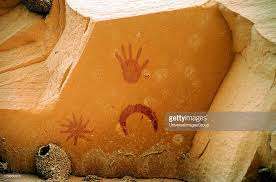
Overshadowing?
'Higher' or 'lower'?
Question. Boredom?
Grey Worm? {Game of Thrones}.
Refresher: ''The siren heralds a friend, the bee a stranger.''
''Truth is stranger than fiction.''
REFRESHER: "What is decisive for me is that i dream about physics as Mr. Jung [and other non-physicists] think about physics. Every time i have talked to Mr. Jung [about the ''synchronistic'' phenomenon and such], a certain spiritual fertilization takes place." Wolfgang Pauli.
 From a different perspective: "Frater V, had a lucid dream in which he was being held within a perfect blue cube, {''squarely''?} with a 'stranger'. The walls of the cube were composed of living and vibrant conscious patterns. It was within the awareness of the vision that there was no space or time within the cube itself. At this point, the walls of the cube began to swirl in dynamic flow, and the fabric of reality within the space began to change in an indescribable manner. The other person in the cube began to scream and clutch at themselves as their body and soul began to literally unravel in the transition of the space. Frater V, felt a fear unlike anything he had ever encountered. This was the very undoing of the Adeptus Major into the realm of Chesed and it had little to do with the Mercy or loving kindness associated with the sephirah. When awakened from the dream, he considered what the real experience might be like - and why anyone would wish to undo themselves so." [Extract from the book 'The Magister'. Emphasis, this readers]. Try ''cube'' / ''undoing''.
From a different perspective: "Frater V, had a lucid dream in which he was being held within a perfect blue cube, {''squarely''?} with a 'stranger'. The walls of the cube were composed of living and vibrant conscious patterns. It was within the awareness of the vision that there was no space or time within the cube itself. At this point, the walls of the cube began to swirl in dynamic flow, and the fabric of reality within the space began to change in an indescribable manner. The other person in the cube began to scream and clutch at themselves as their body and soul began to literally unravel in the transition of the space. Frater V, felt a fear unlike anything he had ever encountered. This was the very undoing of the Adeptus Major into the realm of Chesed and it had little to do with the Mercy or loving kindness associated with the sephirah. When awakened from the dream, he considered what the real experience might be like - and why anyone would wish to undo themselves so." [Extract from the book 'The Magister'. Emphasis, this readers]. Try ''cube'' / ''undoing''.
Question. Archetypes of his 'future' self? i.e., bottom up coming to a 'head' {and/or 'realization'} with top down? A potential yet to be realized? Understanding what all infer by the ''divine bit'' within that universal framework makes sense of that question {hypothesis?}.
Try ''Olmec head''.
That ''potential'' is within sight, {'horizon' link} but ahead of 'time'. That link to K. Godels book and quotes on same. Enlarged elsewhere.
N.B. Chesed below the 'void'.
'Being and Time' / Martin Heidegger.
Side note: {something hinted at - if only in 'mythic' form}: "But this time I knew something was different...this time my nightmares had come upon me for my death. And at that moment I knew beyond all doubt, that even a dream, at times, was enough to kill. From out of this personal hell, I remember seeing the face of Merlyn floating among the mists, as if to encourage me onward. Under the eyes of my mentor, I found the renewed...." [From the chapter entitled the 'The Haunted Mountain' from within the book by Douglas Monroe].
The Mare Way ? {5:6}
Question. A 'flat' top?

Twisted strands throughout.
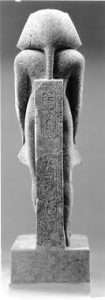
"Mould" = Primary over secondary?
As seen from a different perspective {the pagan one?}: "So Ariadne is the Weaver Goddess, the Great Goddess of the ancient cultures, and, most important for us as modern people, a powerful mode of consciousness and energy {recall J. Campbell's quote}. Whether we see the universe as a random collection of exploded matter or the product of a patriarch creator, such conceptual models steer our own reality, tending to both mould and limit our understanding and self-expression. If we approach the universe as Ariadne, the Weaver of the Void, we are open in response to her. Her power is that of becoming - whatever we may become....And her power is that of Unbecoming, for whatever is made is simultaneously unmade. She is the gate of the Void through which infinite potential and dissolution flow. The threads of her weaving....three main strands of energy, time and space - co-existent." [Page 132, 'The Way of Merlin'].
'Arachne Rising: The Search for the Thirteenth Sign of the Zodiac' / J. Vogh.
''Void'' in relation to ''transmuted/untransmuted'' and/or ''dissolution/involution''. While recalling that some spiders are 'poisonous'. And/or consume the 'male'. Anima over spirit? or osmosis of both? All as a means...?
And/or: The word in italics in relation to ''undoing''. See it? i.e., {in one form} - pos./neg. - one way or the other. Try lucky/unlucky.
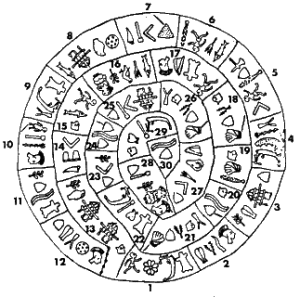
The Phaistos Disk. Snake form? Something coiled {'asleep'?} ready to 'spring' to life?
Analogy: "In Theology this 'pure consciousness' is Siva, and 'His' power {Sakti} who as - 'She' is in her formless self - is one with him. She is the great Devi, the mother of the universe who as the Life Force resides in mans body in its lowest center at the base of the 'spine' just as Siva is 'realized' in the highest brain center - the cerebrum or Sahasrara-Padma. Completed Yoga is the union of her and him....This is Laya or dissolution, the reverse of Srsti or involution of 'spirit' in mind and matter." [Page 27 'The Serpent Power' / J. Woodroffe].
N.B. ''Life force'' in relation to that 'universal BIT' ? A connectedness of something by way of the OBJECTIVE process {or would that be ''principle''?}.
How simple yet profound. Understand that {basic?} principle to decipher the CORE ESSENCE of all 'esoteric' literature.
Potential / Kinetic?
SIDE NOTE: "The science of the I Ching, indeed, is not based on the causality principle, but on a principle {hitherto unnamed because not yet met with among us}, which I have tentatively called the 'synchronistic' principle. My occupation with the psychology of the unconscious processes long ago necessitated my casting around for another explanatory principle, because the causality principle seemed to me inadequate for the explanation of certain remarkable phenomena of the unconscious {Wolfgang Pauli?}. Thus I found, that there are psychic parallelisms which cannot be related to each other causally, but which must stand in another sort of CONNECTEDNESS. This connection seemed to me to lie mainly in the relative simultaneity of the events, therefore the expression 'synchronistic'..." [Page 141, The Secret of the Golden Flower / R. Wilhelm WITH a commentary by G. Jung].
Try ''simultaneous'' to see subject material in the universal sense of the 'word' - since the oral tradition BEFORE ''the written word came into common use''.
Continued: Question. Who was Ariadne 'married' {osmosis?} to? That link to the word ''co-existent'' as a means...?
Question 2. What would the vine represent?
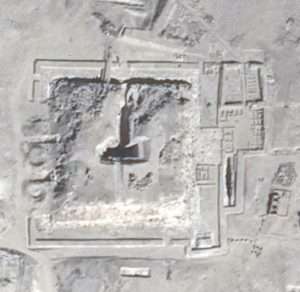
upside down?
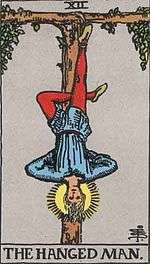 Analogy {the micro within the Macro?}: "Astrology is the only model I have come across which sufficiently reflects the subtle complexities of the human condition, and there are times when we all have to suspend disbelief as we pick it all to pieces, until we can begin to 'see' the whole picture, at which point we can begin to put it all together again." ['Mapping the Psyche' / vol. 1].
Analogy {the micro within the Macro?}: "Astrology is the only model I have come across which sufficiently reflects the subtle complexities of the human condition, and there are times when we all have to suspend disbelief as we pick it all to pieces, until we can begin to 'see' the whole picture, at which point we can begin to put it all together again." ['Mapping the Psyche' / vol. 1].
Question. Spider = scorpion? As a means...?
"Astrology would be an excellent example of manifest synchronicity if it had at its disposal thoroughly tested findings. But at least there are some facts thoroughly tested and backed by a wealth of statistics which make the astrological problem seem worthy of philosophical investigation. {Psychology has no difficulty in recognizing this, since astrology represents the summation of all the psychological knowledge of antiquity.}'' [Page 142, 'The Secret of the Golden Flower' with a commentary by C. Jung].
Analogy: "Reconnecting strands implies that rather than continuing to evolve forward in a near linear fashion, the human race will benefit by simultaneously reaching back in time and bringing forward certain aspects from when we were a more 'complete' people." ['The Reconnection'. Mentioned elsewhere].

''The beautiful woman {stranger?} has come''? Symbolic or real? Recall Solomon's 'wife'.
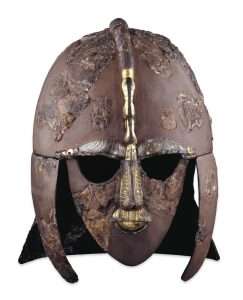
Duality? A meeting of the two in the ''middle'' of the forehead?
Same thing - different perspective - can u 'see' it?..."All knowledge is the result of illumination from above, not of abstractions from below. And in the mystical angelologies of Avicenna and Suhrawardi, that active intellect, which is merely conceived by abstract theorizing {i.e.,objectively?}, is actually encountered in the 'Event' - at the limit of the cosmos - {i.e.,'boundary' line of higher/lower divisions} - Hence the final sentence - ''as personified and individualised in a Celestial Person {'angel' and/or 'archetype'?}, who is in each case unique. Each human soul has a counterpart in 'heaven', who is the eternal and 'perfected' individuality of that soul, i.e.,at the moment when the soul discovers itself to be a stranger and alone in a world formerly familiar, a personal figure appears on its horizon, a figure that announces itself to the soul personally, because it symbolizes with the souls intimate depths. In other words, the soul discovers itself to be the earthly counterpart of another 'being' {archetype?} with which it forms a 'totality' that is dual in structure. The two elements of this dualitude may be called the ego and the Self, or the transcendent celestial Self {'manifested'?} and the earthly Self {UNmanifested?} - or by still other names. It is from this transcendent Self that the soul originates in the past of metahistory; this 'Self' had become strange to it while the soul slumbered in the world of ordinary consciousness; but it ceases to be strange to it at the moment when the soul in turn feels itself a stranger in this world." [From the book 'The World Turned Inside Out: Henry Corbin and Islamic Mysticism'. Mentioned elsewhere. Emphasis, this readers].
''Event'' in relation to bridging a 'gap' and/or 'void' {Hebrew equivalent 'Daath'}.
A 'connection' therefore between the 'Western Way' and Islamic / Hebrew mysticism?
A working example? {in relation to the intent of the word ''undoing''}: "For a long time, simply the aim of seeing what is occurring is a major one indeed. Eventually, you move from recognizing negativity {for instance} and its toxic impact on your life, to making the effort of not expressing it, and then to making the choice in the moment to transform it into neutral energy which is used for generating a more serene state of consciousness. This is the prototype for the stages, whether dealing with inner considering, negative imagination, false personality, features etc..." ['Wisdom of the 4th Way']. Continued elsewhere.

''Pure'' link?
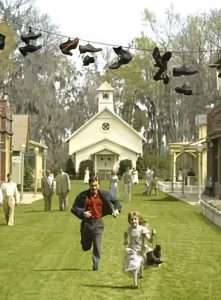
"Friend. What happened to you're shoes? They kinda got ahead of me." {'Big Fish' / 2003].
And {in relation to the above}: "One's sense of identity shifts and a truer, 'purer' quality of self replaces the narrow, identified second state. A sense of harmony arises from this new perspective and understanding {new 'name'?}. This experience can form a permanent faculty in one's psychology where that consciousness is present. The Work calls it ''an organ of perception'' formed by understanding, growth in being, and illumination. That 'level' of consciousness is available not only ahead of us in time but above us in time as well." [Same book].
''Ahead'' in relation to E/W {horizontal?}. ''Above'' in relation to S/N {vertical?}. That 'connectedness' {mid-point?} = that {new?} 'level of consciousness'? Anything?
''Pineal'' link?
Analogy with the same intent: " Where 'two' beings are separated from one another by a veritable abyss, no bridge of understanding can be created between them; if an understanding is ever to be reached, it must be because they have understood one another before - and in another way. The writer of this book has tried to find that ''other way'', confident that somewhere in the depths of the heart that previous understanding exists in all of us, but has been forgotten." ['The Flaming Door']. Try ''forgotten.'' Part 1?
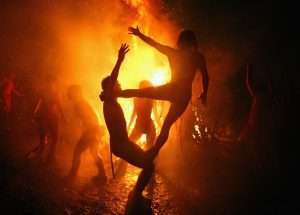
Triangles: 'Fire and water' which and why?
Analogy? OR {proof?} in only to that {this?} individual - of a work in progress: "It was in the 2nd Degree that i had my first vivid psychic experience, in the less than romantic aura of RAF sergeants quarters. In the midst of quiet routine meditation i was startled by the imaginative impression, very powerful, of the bearded head and shoulders of an ancient looking man. Some time later i recognized its likeness to a statue of Melchizedek at Chartres Cathedral - an early biblical figure, strangely described as ''without father or mother, without descent'' who appeared to the patriarch Abraham, bearing bread and wine, in an ancient priestly function. What was particularly striking was the sense of power and benevolence that came with this vision. It was an isolated incident, but it gave me the feeling that i was beginning to get somewhere - and would not have to rely forever on the spiritual or psychic expressions of others." ['I Called it Magic' / G. Knight]. Try ''unobtrusive observer'' for another example {principle?} by same author.
Question. From a 'Pagan' perspective: which of the three i.e., past/present/'future' does the above example belong to {i.e., Taliesin/Amergin/Bluestar}? Enlarged Elsewhere.
Proving the validity of {say} a study exercise as well the 'ritual' one OR any other 'method'. BECAUSE those keys are universal - REGARDLESS of how they are understood.
AND anything understood sooner or later emerges into consciousness. In the fullest sense of the 'word' {logos?}. Wheel of Life?

Bull {Taurus}, scorpion, dog, snake.
Analogy? ''Without father or mother'' = "Only then would they begin to appreciate Gods true nature: a spiritual presence ''nearer to man than his jugular vein." Anything? [Enlarged elsewhere].
Side note: Alternative ''Head and shoulders'' information found in 'Homers Secret Iliad'. Coincidence or a meaningful one?
And/or ''bearing bread and wine'' - Try ''wheat'' / ''barley'' for a further {deeper?} connection.
Question. Jung in relation to Philemon? Enlarged elsewhere.
'The Sword in the Sun' / A. Duncan.
 'See' a connection to the following: ""The esoteric function of the nome in the body of Egypt is revealed through the character of the nome spirit. For instance, at the 8th nome of Upper Egypt, the nature spirit of the region was 'Khentiamenti', a figure that both guarded and led the way to ''the hidden land'' of the departed, 'Amentet'. It was believed in ancient times that the entrance to Amentet, over which Osiris presided, was physically located in the region between Thinis and Abydos, ''between the two hills'' {'horizon' link?}, a reference to the 'shoulders' of Khentiamenti. Thinis, the earlist burial place of royal persons known in Egypt, was later {evolution of?} incorporated with the town of Abydos and assumed a nome standard called ''the shrine of the head'', identical to that of the Osirian relic depicted in the reliefs at the Abydos temple, where the head of Osiris was said to be enshrined. Khentiamenti, the earthly governor of the area, assumed the form of Osiris as a shadowy, mirror image of the celestial power with which he was associated. But more importantly, Abydos as the ''head'' of the terrestrial body of Osiris represented the place where the neter's form spread itself northward over the Nile." [From the book by Rosemary Clark].
'See' a connection to the following: ""The esoteric function of the nome in the body of Egypt is revealed through the character of the nome spirit. For instance, at the 8th nome of Upper Egypt, the nature spirit of the region was 'Khentiamenti', a figure that both guarded and led the way to ''the hidden land'' of the departed, 'Amentet'. It was believed in ancient times that the entrance to Amentet, over which Osiris presided, was physically located in the region between Thinis and Abydos, ''between the two hills'' {'horizon' link?}, a reference to the 'shoulders' of Khentiamenti. Thinis, the earlist burial place of royal persons known in Egypt, was later {evolution of?} incorporated with the town of Abydos and assumed a nome standard called ''the shrine of the head'', identical to that of the Osirian relic depicted in the reliefs at the Abydos temple, where the head of Osiris was said to be enshrined. Khentiamenti, the earthly governor of the area, assumed the form of Osiris as a shadowy, mirror image of the celestial power with which he was associated. But more importantly, Abydos as the ''head'' of the terrestrial body of Osiris represented the place where the neter's form spread itself northward over the Nile." [From the book by Rosemary Clark].
Question. Why should that ''be most important''?
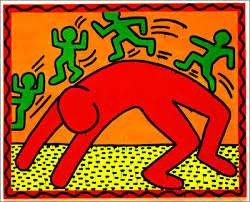 'Diamond of Virgo'? [Page 259, 'Star Names and Their Meaning'].
'Diamond of Virgo'? [Page 259, 'Star Names and Their Meaning'].
'Mans Search for Meaning' / Viktor Frankl.
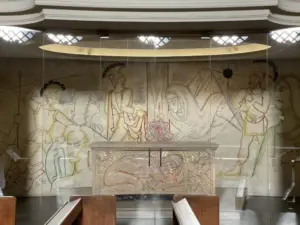
But the most famous artworks associated with Notre Dame de France are the paintings by Jean Cocteau, his only murals outside France.
A work in progress: ''What was of interest in Louis Charpentier's book 'The Mysteries of Chartres Cathedral' was his revelation that the Notra Dame cathedrals of Northern France were laid out to a definite plan. Each cathedral represented a different star in the constellation Virgo - in diamond shape....Gothic in design: ribbed vaulting, flying buttresses, large areas of stained glass and, above all, pointed arches...Originated from the east to be developed in France....Over an enormous area - unlike the smaller area of Giza in Egypt....The profusion of pointed arches amongst the ruins of the old buildings at Edessa testify to the early Gothic style...'' [Page 246-8 'Magi: Quest for a Secret Tradition'].
N.B. Edessa: the Blessed City. [Page 288]. + 'Hay' and Mount Ararat links.
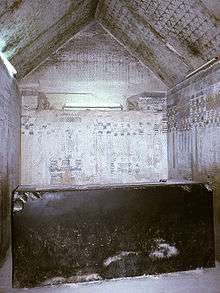
Pointed?
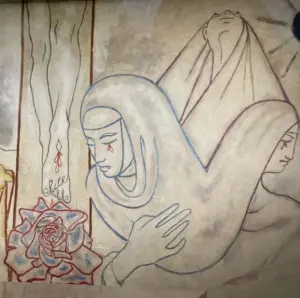
The Church of Notra Dame de France - Soho - London. Aries-Pisces?
And/or: ''Is the cathedral of Chartres the lineal successor of the Dolmens under which the Druids fitted their novices for initiation.?'' [Back cover to the book by Charpentier].
Refresher: ''In French, fleur-de-lis literally means "lily flower". It may come as no surprise that an emblem found all over the state of Louisiana has its roots in a flower from French culture, stemming from the French colonization of the Americas, particularly present day Louisiana.''
''The Trilithon is a design familiar within the arches of Stonehenge, a Celtic Dolmen, or in the earthly entrance to a mine or cave. It is symbolic of the 'womb' and 'tomb' concept, of the earth mother who 'births' us - and whose dark flesh {unknown aspect} embraces us again at 'death'. It is an entirely female form, whose shape is in itself a mystical 'gateway' from the 'past' into the 'future'. It is symbolic of Earth." [Page 110 from the book by D. Monroe].
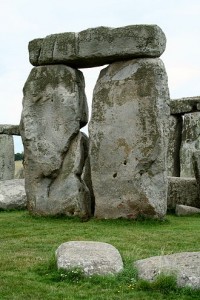
'Hippo' and 'Croc' in a different form?
Side note: Page 32 of the book 'On Having No Head' / D. Harding. The words ''gate'' and ''Void'' in relation to Qena. And "But reverse the arrow of attention, and at once we enter the realm of Certainty." {Page 60} - in relation to the ''Arrow of Time''. As a means...?
Try 90 degrees or would that be 180*?
''Attention'' in relation to: ''By 'the spirit' {ruab} the prophet {Ezekiel} does not mean ''the wind,'' but ''the intention'' as we have explained when discussing the homonym ruab {spirit}. [Page 253].
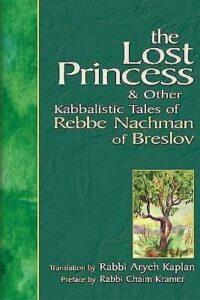
The Golden Mountain is the key to the entire second part of the story. From the context, the fact that the mountain is made out of gold alludes to the fact that ordinary wealth and riches are not worth anything there....Thus, the Shekhinah is hidden in a place of untold wealth. As we shall see from the context of the story, this appears to be the World to Come..In the lesson which is said to be the key to this story, Rabbi Nachman teaches that for deep understanding of the Torah (finding the Shekhinah) one needs great wealth. Thus, in order to find the King's Daughter, one must first find a golden mountain. Perhaps the mountain represents the ark, since prophecy came from between the two gold cherubs, over the golden ark. This is now hidden on high. This may allude to the place of souls. Indeed, it is taught that the purification of souls parallels the purification of gold. Some say that this is alluded to in the verse: “Its stones are the place of sapphires, and it has gold dust. No bird of prey knows that path; neither has the falcon's eye seen it. The proud beasts have not trodden on it; nor has the lion passed it by" Job 28:6-8). Hence, later in the story, neither the birds nor the beasts know it (Biur HaLikutim 60:67; Rimzey Maasioth, Hashmatoth). And/or: Actually, as we shall see, the instrument was made of the same wood as the throne. This might be significant, since, as we shall see, the instrument is representative of the ark. The ark contained the tablets, and they were made of sapphire, the same material out of which the Throne of Glory is made. It is thus written, “They saw under God's feet a brickwork of sapphire” (Exodus 24:10). This is the sapphire out of which the tablets would be made.
Together with: "When he commences to describe the firmament in detail, he says ''the firmament'' without adding the words ''the likeness of'' for he says, ''And I looked and behold, in the firmament that was above the heads of the cherubims {i.e.,'younger' aspect of something} - there appeared over them as it were a sapphire stone, the appearance of the likeness of a throne.'' Here he speaks of ''the firmament'' and not of ''the likeness of same'' as he does when he connects the firmament with the heads of the likeness of the Hayyot. But, as regards the 'throne', he says, ''the likeness of a throne appeared over them,'' - in order to indicate that the firmament was first perceived and then the likeness of the throne was seen over it. Note this well." [Pages 253 and 259/260 'Guide for the Perplexed].
Question. Recall what was found at Denderah. The first ever. That relationship with the ''Firmament.'' Horizontal/vertical. Horizontal with the 'figure' at Abydos. Therefore....?
"....Sirius being the star of Horus, and the Step Pyramid complex being named Horus Is the Star at the Head of the Sky." [Page 134 'Imhotep the African'].
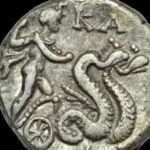 Something extra: ''An example of such a wine label is Star of Horus on the Height of Heaven (this vineyard estate started around 2600 bce or the time of Zoser and lasted to 300 ce); Northern Xois District, Chassut Red (Chassut Red was reputed to be not ready to drink until it had aged 100 years!), Sekem-Ka, vintner; very, very fine grade....Many scenes from tombs gives us a fairly accurate picture of the Egyptian vineyards and the techniques of wine production. The best site to locate a vineyard was on a hill, but if there wasn't one than the Egyptians made an artificially raised plot of land and planted the vines there. A wall generally enclosed the area and vegetables and fruit were planted with the grapes. They were watered by hand generally from a water basin.'' [www.touregypt.com].
Something extra: ''An example of such a wine label is Star of Horus on the Height of Heaven (this vineyard estate started around 2600 bce or the time of Zoser and lasted to 300 ce); Northern Xois District, Chassut Red (Chassut Red was reputed to be not ready to drink until it had aged 100 years!), Sekem-Ka, vintner; very, very fine grade....Many scenes from tombs gives us a fairly accurate picture of the Egyptian vineyards and the techniques of wine production. The best site to locate a vineyard was on a hill, but if there wasn't one than the Egyptians made an artificially raised plot of land and planted the vines there. A wall generally enclosed the area and vegetables and fruit were planted with the grapes. They were watered by hand generally from a water basin.'' [www.touregypt.com].
''Roses can be planted in vineyards as an early warning system to indicate if any diseases are present.'' ['The Chase'].
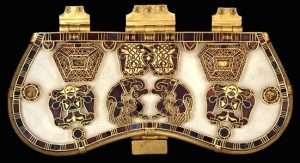
Sutton Hoo purse clasp: Wolfs / eagles and ducks.
Side note: 'Instrument': Keli in Hebrew. It was a box, as we see later in the story. In the first story, keli denotes a purse.
Rabbi Nathan writes that in the order of prayer, this song of the animals represents the Pesukey DeZimra (literally: “verses of song”) which comprise the second part of the morning service. Song is what refines the human spirit and separates it from the animal in man (cf. Likutey Moharan Tinyana 63). Later he also gets an instrument which can make every animal sing—this is very much the same concept, as we shall see. The Pesukey DeZimra are read after the korbanoth, just as the Levites would sing their song when the sacrifices were offered (Likutey Halakhoth, Birkath HaShachar 3:28).
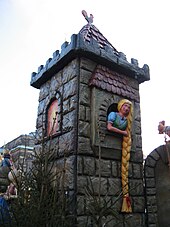
'Forest of oaks'.
The forest man said to them, “Why do you find this so novel? I have an instrument* that I received from my ancestors, who in turn inherited it from their fathers’ fathers. The instrument is made with special leaves and colors.* When this instrument is placed on any animal* or bird, the creature immediately begins to sing this song.”
Special leaves and colors: Or leaves and colors. Actually, as we shall see, the instrument was made of the same wood as the throne. This might be significant, since, as we shall see, the instrument is representative of the ark. The ark contained the tablets, and they were made of sapphire, the same material out of which the Throne of Glory is made. It is thus written, “They saw under God's feet a brickwork of sapphire” (Exodus 24:10). This is the sapphire out of which the tablets would be made.
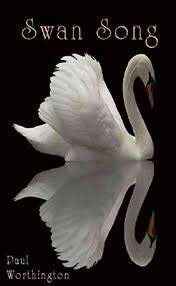
REFRESHER: ''The Swan is white without spot.''
Rabbi Nathan writes that the king's true son's getting this instrument parallels the part of the service known as Pesukey DeZimra—the “verses of song” (Likutey Halakhoth, Birkath HaShachar 3:28). This parallels the world of Yetzirah, which is the world of the chayoth which support the throne. These chayoth sing when they lift the throne. In general, this instrument is then seen as the Torah. The Torah has the power to refine the animal element in every person. It is also seen as the power of the tzaddik, which can refine the animal in every person and make him “sing” (Oneg Shabbath, p. 297).
There is also a Breslover tradition that this instrument is the advice given by a tzaddik.
